


















Saturday Sept. 7 11:00 am (to Feb. 23, 2025)
Thursday, Sept. 12 7:00 pm
Sunday, Sept. 15 1:00-3:00 pm
Thursday, Sept. 19 7:00 pm
Friday, Sept. 20 6:00 to 9:00 pm
Saturday, Sept. 21 2:00 to 4:30 pm



Thursday, Sept. 26 6:30 to 8:30 pm
Saturday, Sept. 28 10:00 am to 12:00 pm
Roger Mooking: Soundbites exhibition opens to the public
Admission for SoundBites exhibition is FREE
Opening Celebration Free admission to all AGH exhibitions
Family Fun Day
Artist Talk: In Conversation With Roger Mooking
WordBites Writing Workshop with Anne Bokma
AGH Members: Free General $5.00
AGH Members: $10 General $15
Gather By The Grand Picnic & Star Gazing at Chiefswood Park, Brantford Pay What you Can
AGH Members: $40 General $50
Devi Triptych Reading With Radha Menon Free
Make Your Mark Art Workshop with Nathan Eugene Carson
Sunday Sept. 29 1:00 to 4:00 pm ACCA Fabulicious
Tuesday, Oct. 1 6:30 to 9:00 pm Architectural Film Screening
Thursday, Oct. 3 4:30 to 6:30 pm
Friday, Oct. 4 7:30 to 11:00 pm
Friday, Oct. 4 6:00 to 10:00 pm
Sunday, Oct. 6 6:00 to 9:00 pm
Wednesday, Oct. 16 6:30-8:30 pm Sounding Spaces Free + date + event + tickets
AGH Members: $40 General $50
AGH Members: $20 General: $25
AGH Members: $10 General: $15
Youth Rap Beats & Poetry Workshop with LTtheMonk Free
Vinyl Night: 90’s Hip Hop Edition
Art Circuit Reception at AGH 6:00 to 7:00 PM (ticket holders only)
AGH Members: $10 General: $15
Art Circuit Hop-On/Hop-Off Bus Tour 7:00 to 10:00 PM General: $50
Festival Finale Dinner: A Roger Mooking Experience
AGH Members: $50 General: $60
123 King Street West 905.527.6610 x272 artgalleryofhamilton.com
Free Thursdays: 11 am - 9 pm
Fridays: 11 am - 6 pm
Saturdays & Sundays: 11 am - 5 pm
MEREDITH M acLEOD EDITOR CO-FOUNDER / CO-PUBLISHER
WILL VIPOND TAIT
CREATIVE
DIRECTOR CO-FOUNDER / CO-PUBLISHER
SALES DIRECTOR
JESSICA POTTER
SALES
JASON ALLEN
FINANCE + SUBSCRIPTIONS
GORDON MUISE
CIRCULATION
JEREMY FREIBURGER
PROOFREADERS
SHERRI TELENKO
JESSICA ROSE
PRINTING
DOLLCO PRINT SOLUTIONS GROUP
It’s been quite a year for local media in Hamilton. As CHCH celebrates 70 years on the air in 2024, it’s important to reflect on just how important the station has been to the identity of Hamilton. It is one of just a few independent broadcasters in the country and it has punched above its weight throughout its history.
Check out our feature that examines some of that history but also, more importantly, the present and future of Hamilton’s broadcaster. It’s found a new home in Waterdown, embarked on new content streams and rededicated itself to its local focus.
On the other hand, the devastating loss of 900 CHML is a cautionary tale. The broadcaster was a fixture in this city for 97 years and among the oldest radio stations in Canada. It was a place where local news and news talk ruled and for many Hamiltonians over generations, the station was part of their daily lives.
Owner Corus Entertainment announced the closure on Aug. 14 and within an hour or so, the station’s spot on the dial was static. The corporation blamed the closure on shifting advertising trends and “the increased and unregulated presence of foreign-owned media platforms.”
Despite the valid point about foreign-owned social media platforms gutting news media, this is the danger of mass corporate ownership of local outlets. From the executive suites in big cities, there is no genuine commitment to the community or to journalism. The overriding commitment for high-paid executives is to shareholders. Full stop.
It’s about a year ago that Metroland Media Group declared bankruptcy, shutting down its six weekly print community newspapers in Hamilton and laying off 605 people across Ontario. That has left a huge gap.
There were genuine concerns at the time – that remain today – about the future of the Hamilton Spectator, a 178-year-old institution in this city, which now operates without a physical newsroom.
HAMILTON CITY Magazine (HCM) is published by Hamilton City Publishing Inc. All rights reserved. Content may not be reprinted without written permission.
©2024 Hamilton City Publishing Inc.
HCM is a member of Magazines Canada. HCM basic price: $35 (HST includedfive issues). Single copies: $7.95 (plus HST).
HCM (ISSN 2816-7449) is indexed in the Canadian Periodical Index. Printed in Canada by Dollco Print Solutions Group. Canada Post Publications Mail Agreement #44039515.
Contact Us:
270 Sherman Ave. N, Studio 301 Hamilton, ON L8L 6N4
info@hamiltoncitymagazine.ca hamiltoncitymagazine.ca
The Spec continues to do incredibly important work despite the challenges in resources it grapples with every day. One bright spot: the paper is now under the leadership of a new editor-in-chief in Cheryl Stepan, a respected, experienced and talented journalist out of the ranks of the newsroom.
We must as a community commit to supporting and investing in our local media outlets in whatever ways we can. They are the only ones who will tell us what is happening in our city, ask the tough questions, give voice to the voiceless and make sure those who hold power act with integrity, competence and responsibility.
If you’d like to support the work of the independently and locally owned HAMILTON CITY Magazine, which enters its third year of production with this issue, please subscribe, buy us from a retailer or advertise with us.
– Meredith MacLeod and Will Vipond Tait








we’re always WORKING to make jackson square a great place to shop, eat, and visit. Share your thoughts in our survey for a chance to win 1 of 3 Jackson Square t-shirts!
Celebrating 52 Years in downtown hamilton Follow @jacksonsquarehamilton on Instagram for regular updates.
Marta Hewson for HAMILTON
8/ BUILDING A STRONGER HAMILTON
Strong Towns conference in Cincinnati –and the city itself – offer plenty of examples of what we can do to build a livable, inviting city for residents and visitors.
16/ FINDING A WAY FORWARD
Wayside House offers residential addiction treatment and supportive housing programs to men and male youth who are seeking sobriety. One of many success stories, Matt is finding new purpose after drug dependency and life on the streets.
22/ TAKING TO THE STAGE
Main Stage Rehearsal Studios offers a range of rental studios and performance spaces for musicians and podcasters, with the goal of supporting artists at all points in their career.
32/ CHAMPAGNE STYLE
Guitarist, songwriter and producer
Champagne James Robertson is a newcomer to Hamilton, not to mention one of the city’s busiest musicians.
42/ A WAY WITH WORDS
Hamilton publishing house Wolsak and Wynn now includes three imprints producing fiction, non-fiction and poetry that challenge, enchant and refuse to conform.
56/ HOT DATE, HOT EATS
Swipe right on these restaurants when you are aiming for romance and great food.
58/ IT TAKES A VILLAGE
Ancaster has a lot going for it, including some great places to eat and shop for food in its most historic neighbourhood. This is part of an ongoing series looking at the local array of dining districts.




The City of Hamilton is situated upon the traditional territories of the Erie, Neutral, Huron-Wendat, Haudenosaunee and Mississaugas. This land is covered by the Dish With One Spoon Wampum Belt Covenant, which was an agreement between the Haudenosaunee and Anishinaabek to share and care for the resources around the Great Lakes. We further acknowledge that this land is covered by the Between the Lakes Purchase, 1792, between the Crown and the Mississaugas of the Credit First Nation.
Today, the City of Hamilton is home to many Indigenous people from across Turtle Island (North America) and we recognize that we must do more to learn about the rich history of this land so that we can better understand our roles as residents, neighbours, partners and caretakers. Both the National Day for Truth and Reconciliation and Orange Shirt Day take place on Sept. 30 and recognize that at least 150,000 Indigenous children from across the country were forcibly separated from their families and their communities.





OCT. 30 - NOV. 16, 2024

A smart political comedy that navigates the drama and the absurdity of the Quayside boondoggle in Toronto!
CRITIC’S PICK
The Globe and Mail
“The Master Plan is close to a perfect play…Technically complex and visually stunning, Abraham’s cast is excellent.” Intermission magazine
FEB. 19 – MAR. 8, 2025
12, 2025 DEC. 4 – DEC. 21, 2024

26 –

HAMILTON DAY, NOV. 1-3, CELEBRATES ALL THE LOCAL BUSINESSES THAT MAKE THIS CITY GREAT.
Hamilton Day is no longer a day, it’s now a weekend of celebrating local businesses and promoting the importance of keeping shopping dollars in our city.
An initiative of the Hamilton Chamber of Commerce, this year’s Hamilton Day, Nov. 1-3, is expected to draw participation from more than 1,000 retailers, restaurants and bars, markets, cultural attractions, independent artists and musicians and personal service providers.
“We really leave it to the business community to identify how they want to participate,” says Katie Stiel, senior manager of strategic initiatives with the chamber. “It’s really their platform, and so it’s open for them to participate in a way that best suits their needs.”
Hamilton Day has a growing range of programming partners, too, everything from House of Adam & Steve drag brunches to activations at local libraries to the Art Gallery of Hamilton offering free admission. The city’s 11 BIAs will also offer pop-up markets, live music performances, face painters, balloon artists and DJs.
“Our partnerships help to create opportunities for
Hamiltonians to experience, explore and celebrate all corners of our city,” says Stiel.
The weekend will conclude on Sunday with the Hamilton Road2Hope Marathon and Dance Masters of Canada.
“Hamilton Day is about more than just shopping local and supporting small businesses; it’s about investing in the heart and soul of our city,” says Greg Dunnett, president & CEO, Hamilton Chamber of Commerce. “Small business owners are the backbone of our economy, driving innovation, creating jobs, and fostering a unique sense of community that makes Hamilton thrive.”
Hamilton Day began in midst of the Great Depression in 1931, when the chamber hosted a day to help boost spirits and the local economy. The event was revived 90 years later in 2021, when the pandemic meant the community needed another reason to celebrate and come together.
It was supposed to be a one-off event, but it took off and has been growing in audience and impact ever since.
Hamilton Day was recognized as a Top 100 event in Ontario by Festivals and Events Ontario this year. n

BBy PAUL SHAKER
ack in May, a group of intrepid Hamiltonians made the trek south of the border to attend the Strong Towns National Gathering in Cincinnati, Ohio. It was an inspiring few days that raised many issues and opportunities relevant to Hamilton. Aside from the conference itself, the city of Cincinnati was a delightful surprise.
First, the Strong Towns gathering. Strong Towns is a non-profit organization that advocates for a change from the North American post-war pattern of development in cities, including unchecked urban sprawl, to a pattern of development that is financially strong and resilient. Strong Towns advocates for cities of all sizes to be safe, livable and inviting.
The organization works to elevate local government to be the highest level of collaboration for people working together in a place, not merely the lowest level in a hierarchy of governments. Strong Towns supports thousands of people across the United States and Canada who are advocating for a radically new way of thinking about the way we build our communities.
The Strong Towns National Gathering brought together people from across North America from a wide variety of backgrounds and professions. Many projects and lessons

learned were shared with participants, and a few themes stood out. First was the idea of having a sense of urgency around initiating improvements in communities. No matter what the problem was, big or small, the ethos of “do something now” to make the situation better kept reoccurring. It was described as a four-step approach to public investment:
1. Humbly observe where people in the community struggle.
2. Ask the question: What is the next smallest thing we can do right now to address that struggle?
3. Do that thing. Do it right now.
4. Repeat.
This applies to all segments of the community. If the municipality was taking too long to fix a problem, or undershooting the solution so that the problem wouldn’t be fixed, there are a variety of ways residents can demonstrate the value of improvements immediately. Some call it tactical urbanism, others simply apply creative thinking, and a step in the right direction can occur. Once demonstrated, more formalized solutions can be adopted. Examples of this included making streets safer with temporary design changes or using paint to enlarge spaces for pedestrians. One presentation from a smaller town in western Canada described how they solved an issue of publicly accessible restrooms in their downtown. The initial idea was to spend hundreds of thousands of dollars on new facilities, money the municipality didn’t have. Instead, civic leaders simply took a step back, mapped out and extended the hours of existing facilities within easy walking distance, and communicated the options to residents and visitors. This solved the problem immediately, while also saving the significant expense of building new facilities. It’s a small thing, but makes a big difference to the accessibility and enjoyment of a community’s downtown. On a larger scale, there were presentations on how to quantify the impact of urban sprawl and a lack of density. We all know sprawl is expensive, very expensive, but to be able to put a price tag on it, is eye-opening. Once you figure out how much property tax is generated per hectare, you get a much clearer picture of what development is wealth-creating and what development is wealth-draining. You can then build a
stronger town with economic sustainability as a foundation. It just makes sense, but right now we do the opposite and watch our property taxes rise each year as services and infrastructure are not properly invested in. It’s time to change our approach.
The city of Cincinnati itself holds a number of informative lessons for Hamilton. Located in, coincidentally, Hamilton County, Ohio, the Queen City as it’s known, has a population of over 310,000 within a metro area of over 2.2 million. The city has experienced a typical North American cycle of growth, decline and renewal over the years, but as it stands now in 2024, there are a number of urban initiatives worth mentioning.
The waterfront (riverfront) has undergone significant rejuvenation, including an extensive park network, some residential development and sports stadiums for the football and baseball teams. It is a major resident and tourist destination filled with panoramic views of the water and the city. This was similar to the plan Hamilton had for the new sports stadium for the Pan Am games and the success in Cincinnati gives a glimpse of what could have been on Hamilton’s west harbourfront.
Cincinnati also has light-rail transit (LRT). The Connector, as it’s called, opened in 2016 and operates on a six-kilometre loop linking the waterfront and downtown, through to the north part of the Over-the-Rhine neighbourhood. Future extensions have been proposed to the Uptown area, home to the University of Cincinnati. During the COVID-19 pandemic, fares were suspended and eventually eliminated. The easy accessibility to multiple business, shopping and residential districts by LRT is something to remember as Hamilton continues on its path to build LRT.
The Over-the-Rhine neighbourhood, a German cultural district, is among the largest, most intact urban historic districts in the United States. Once known as one of the most economically distressed areas in the country, the neighbourhood is undergoing a renewal, with heritage preservation, restoration and public space upgrades evident, including the popular Findley Market.
Newer condo and residential development sit alongside historical buildings. It’s not one or the other, it’s both. Another lesson for
Hamilton as we manage our own residential development boom downtown, one that is greater than what is occurring in Cincinnati. As with many older North American cities, including Hamilton, much of the downtown urban fabric has been eliminated and replaced with surface parking lots. This leaves many large façades of buildings exposed. Cincinnati has used this as a largescale opportunity for public art. ArtWorks is an award-winning Greater Cincinnati non-profit that creates community-based public art. The organization collaborates with community organizations and residents, businesses, governments, foundations, and non-profits to build creative works of art that bolster the region’s global reputation as an arts destination.
Over the past 27 years, ArtWorks has created a city-wide gallery with more than 14,000 public and private art projects, including more than 300 permanent outdoor murals. This makes every turn of a street corner into an opportunity for an aweinspiring experience. While Hamilton has murals, the program in Cincinnati is next level in terms of size and scale.
As a first-time visitor to Cincinnati, it was easy to find your way around the central city. Places of interest were well identified, a free LRT was a convenient way to get there, and walking the streets was a pleasure (although they, too, have a problem with one-way streets and too many traffic lanes). What stood out was a city that people cared about. It wasn’t perfect, it was a work in progress, but it was clean, inviting, and interesting. It got me thinking about how a first-time visitor to Hamilton in 2024 would react stepping out of a downtown hotel. How would they feel walking our streets, trying to figure out where to go? Would they see a city that was cared for, with streets that were clean and inviting?
As with many things in Hamilton, we have the potential to better reflect our best, both to ourselves and to those visiting our city. And in the spirit of that gathering in Cincinnati back in May, let’s get moving on building a stronger Hamilton, right now. n
Paul Shaker is a Hamilton-based urban planner and principal with Civicplan.
By RYAN MCGREAL
One of the highlights of the Democratic National Convention (DNC) in the United States in August was a spellbinding address by former First Lady Michelle Obama, quoting the mother of Democratic presidential candidate Kamala Harris in her repeated exhortation to “do something” in the face of difficulty.
It’s a message we would do well to embrace in Hamilton, where our municipal leaders have raised not doing something to an art form.
It’s not just Hamilton, of course. Across Canadian cities, as urban advocate Gil Penalosa likes to argue, planners and city leaders are prone to an attitude of “ready, aim, aim, aim …” without ever carrying out a plan.
An urban planner and former parks commissioner for Bogota, Colombia, Penalosa addressed the dearth of public parkland in that city by expanding and popularizing a weekly street closure to transform public rights of way into a city-wide linear park network.
He moved to Canada in 1998 and founded 8-80 Cities, a non-profit promoting the design of public space to be inclusive and accessible.
Sounding a lot like Michelle Obama, he insists that in public policy, “Everything is about focusing on doing” rather than hiding behind endless studies. He says leaders should adopt a “ready, fire, aim” approach in which you launch quickly with a pilot project, get feedback, assess how it’s working, and make adjustments as more information comes in.
Meanwhile, Hamilton councillors got a staff report in August proposing that a City-sanctioned encampment for unhoused

residents with security and washroom facilities would cost $112,000 per resident. The response from Mayor Andrea Horwath was … to ask staff to prepare yet another report.
(This reminds me of the time – true story –when the City hired a walkability consultant to help implement policy and the consultant came back with a recommendation to do more consulting.)
Staff also reported that the City is spending $170 million out of its annual budget this year on homelessness supports, of which 70 per cent or $119 million is being covered by the local tax base. We’re spending so much money and yet we’re spinning our wheels when it comes to addressing the root causes of homelessness.
My son recently introduced me to the idea of thinking in terms of “pencil projects” vs “pen projects.” A pencil project is something that easily can be revised or even removed if it turns out to be a bad idea, whereas a pen project is more permanent and needs to be planned more thoroughly.
It seems to me that, while permanent housing for everyone is definitely a “pen project,” our approach to providing temporary and transitional housing for unhoused people would make a lot more sense as a “pencil project” and therefore ideally suited for the “ready, fire, aim” approach in which we – say it with me –“do something” in order to try out ideas and determine what works.
Of course, for that to work we also need to abandon the can’t-do attitude that clobbers every proposal with a litany of reasons it could not possibly work.
For example, when the Hamilton Alliance for Tiny Shelters proposed doing something – specifically, building a pilot project on the grounds of Sir John A. MacDonald school –staff rejected it because the school building is water-damaged and will have to be demolished at some point.
That decision was made in February 2022, and the school building is still standing today. The site could have provided transitional housing – and important data gathering for policymakers – for the past two and a half years. Instead, we did nothing but produce studies.
I opened this essay with a reference to American politics because that country and its political tendencies casts an outsized
shadow across the world, and particularly in Canada.
In addition to the sense of urgency around taking action, another trend in evidence at the DNC was the mainstreaming of what is sometimes called supply-side liberalism: the idea that an important way to ensure everyone has access to a public good is to produce more of it.
If you want, say, housing to be more available, it makes sense to build more housing. From a policy perspective, you can work backwards from the desired outcome, an increased supply of housing, to understand what the barriers are and act to clear them.
Amid the enthusiasm about Kamala Harris’ selection of Minnesota Governor Tim Walz as her running mate, a less-remarked detail of his political story is that when Minnesota passed a law mandating 100 per cent renewable energy statewide by 2040, state leaders recognized that the status quo regulatory framework would make this goal impossible.
So they also passed a comprehensive reform bill that dramatically accelerates the approval process for new renewable energy projects. That’s right: liberals and progressives are coming around on the idea, long conservative-coded, that there is a need to cut red tape and bureaucracy, as long as it’s for socially beneficial projects.
Now that is an American idea I would love to see cross the border. Ontario cities like Hamilton are mired in decades-old zoning regulations that limit density and restrict mixed land use, combined with painfully slow and cumbersome permitting and approvals processes. Add in the ample opportunities for NIMBY opposition to infill development, and new projects can drag on for years before groundbreaking. Too often, the development proponent eventually just gives up.
The provincial government could fix the regulatory approval process in every city through changes to the legislation that governs municipalities, but aside from allowing up to three units per residential property as-of-right and encouraging higher densities along transit corridors, Premier Doug Ford’s primary focus has been on making it easier for developers to keep building single-family sprawl. n


MURRAY VAN HALEM is a cityscape oil painter documenting the urban scenes of Hamilton and Toronto. He started his arts career as a commercial photographer working with large-format cameras to create images for brochures and catalogues. He then worked at the Brampton Daily Times as a photojournalist, and edited and wrote for other publications. A sharp turn in careers saw him become a real estate broker in Brampton in 1988, which he did for 25 years. Upon his retirement in 2013, he returned to his first love, painting pictures. His works, featuring urban streets, factories and harbours, are in private and public collections and he continues to paint in his Dundas studio.
What brought you to Dundas?
My wife Bayla Fishman and I were living on Georgian Bay for 15 years. It is a beautiful place but we found it to be somewhat isolated. The closest major city was Barrie, which was 35 minutes away and seeing family was a two- or three-hour drive. We wanted to be closer to family and at our age we need to be closer to health-care facilities, doctors, and specialists. We considered Toronto but settled on Hamilton. We moved here in 2020 and are glad we did.
What neighbourhood did you and your wife choose and why?
We wanted a condominium and looked at over 20 properties throughout the city. I needed a place that afforded studio space. We discovered that studio and storage space is a scarcity in condo living. We ended up buying a large end-unit townhouse in Dundas that met all our needs. It was simply good luck that we landed here. We love the small-town and historical feel of Dundas, yet it’s close to the city centre of Hamilton with the countryside nearby.
Favourite hangout in Hamilton?
I enjoy Oranje Café on King Street in the International Village. They have great coffee, scones, sandwiches and an eclectic clientele. The café has a Dutch theme and I like that they pay homage to my heritage.
What are your thoughts of Hamilton after living here?
The city has beautiful neighbourhoods but there are other areas that are rugged to say the least. It will take time for these areas to turn around. I’m always surprised at the number of run-down, derelict buildings in the downtown core. The city could be more proactive in enforcing property standards bylaws, if they have them. I like living close to water and Hamilton is on a lake. I think it is natural for humans to live by the water. It’s a source of physical and emotional nourishment.
How would you describe the city as a place to work as an artist?
Being mostly a cityscape painter there is a tremendous amount of inspirational material here. I like doing industrial-themed
paintings and this is the place for that! We moved here in late 2020 in the midst of COVID. Everything was shut, so as a result it took a while for me to find venues and make art connections. I‘ve made some inroads, such as showing at Christ Church Cathedral during Supercrawl, the Hamilton Conservatory for the Arts and the Dundas Studio Tour in October to name a few.
Who inspires you in your art?
I admire the Dutch painters of the Renaissance and the Post Impressionist but Frans Hals is my favourite. He predates all of them. He has a looseness of brushstroke in his portraits that I adore.
How has your lived experience influenced your work?
My years as a newspaper photographer taught me how to look at the world around me with a more inquisitive eye. It also taught me the importance of design. I was printing dozens of pictures per day in a darkroom and making a design decision with each one. I was also working exclusively in black and white, which helped create a stronger image.
How would you describe your artistic style?
People say it resembles Impressionism but the Impressionists were more detailed. I like to think of it as “Suggestionism.”
What Hamilton arts events do you look forward to most?
Last year we discovered the Fringe Festival with so many choices. The Brott Music Festival is another favourite of ours.
What’s Hamilton’s best kept secret?
The great library branches throughout the city.
What does Hamilton need less of?
One-way streets.
What does Hamilton need more of?
Hamilton needs more affordable housing, more building on vacant lots, more repurposing and renovation of derelict buildings.
IF YOU’D LIKE TO BE FEATURED IN FOR THE LOVE OF HAMILTON, PLEASE CONTACT meredith@hamiltoncitymagazine.ca
The days are shorter and the nights are cooler, making fall a fantastic time to experience city life in Hamilton and Burlington. Here are a few of our favourite local happenings.
Books and Brews Book Club hosted by Grain & Grit Brewery Co. encourages you to put down your phone and bury your nose into a book instead – no pesky book report required. Organized by Hazelwood Creative, the monthly get-togethers encourage discussion, thanks in part to the provided questions on a variety of topics. Participate in the discourse as desired or simply listen to the takes of fellow readers while looking thoughtful – even if you’re only just quietly savouring your hoppy refreshment, which is included in the $10 price of admission. Check out the website for upcoming book selections and to register. Next dates: Sept. 25 and Oct. 23. grainandgritbeer.com

Local butcher Jamie Waldron is passionate about his craft and eager to share his knowledge, having authored The Home Butchering Handbook to help home-cook carnivores. For those looking for a more hands-on approach on a larger scale, Waldron now hosts workshops in whole-hog butchery at his Barton Street shop, a practice that minimizes waste and shows respect to the ethically raised animal that made the ultimate sacrifice. With knives and aprons provided, participants learn traditional butchery methods and techniques under Waldron’s guidance at the three-hour class. Students come away with approximately 20-25 lbs of meat to take home – many meals worth of opportunities to say thank you. Oct. 25, 305 Barton St. E. jwaldronbutchers.com
Rather than let someone else do the cooking on your next date night, take matters into your own hands by attending a date-night cooking class, offered by chef-run Gastro Market. Held each Friday evening, the classes feature a set theme and ethnic cuisine, and wrap up with participants enjoying the resulting three-course meal by candlelight in the on-site dining room. Not just for couples, Gastro Market can also accommodate private classes for a minimum of 10 students, and also offers several skills courses to help get Hamiltonians cooking. Fire up their website for more details on all the classes offered, pricing, and upcoming schedule. 193 King St. E. gastromarket.ca
Add a bit of colour to your next night out by joining local artist Karen Klucowicz at her Cotton Factory studio for a date-night painting class. No artistic experience is required at the intimate monthly class, limited to five couples, each with their own workstation affording a bit of privacy for chatting, admiring, or giggling. The night begins with a drawing exercise, moves to some technique work, and culminates in each couple creating a painting of their own, which will surely be wall worthy. All materials are provided, as is a titch of wine and light snacks, because creativity can work up an appetite. 270 Sherman Ave. N. studiok2.ca
If you haven’t heard much about orienteering lately, it’s likely because its enthusiasts are too busy in the woods to talk. Originating in Sweden more than 100 years ago, the sport of woodland navigation continues to have a dedicated following today, with Don’t Get Lost Adventure Running hosting a multitude of local races throughout the year. Armed with only a compass, a detailed terrain map and hopefully a good sense of direction, participants run the course collecting points as they pass designated checkpoints, racing to finish within a set timeframe. Upcoming local races include Peak to Peak (Oct. 20) and Raid the Hammer (Nov. 10). Navigate the website for full details. dontgetlost.org scan the qr code Make our t hings to d o section your go-to destination for city life and arts and culture events listings! ha M iltoncity M agazine.ca
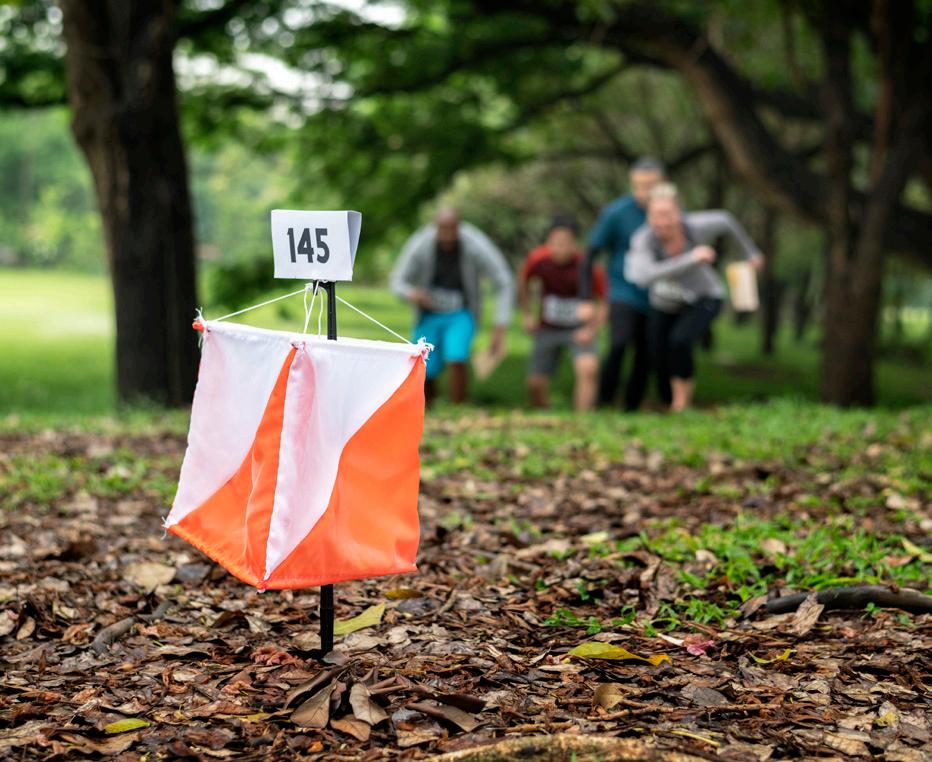

Sass
2. Valerie Cousens, Jim Cuddy and Pamela Norton at It’s Your Festival, Gage Park, July 1.
3. Rob Raco (actor, Riverdale), Nathan Fleet (founder Hamilton Film Festival) and Dana Abraham (writer/ producer/actor Hamilton native) at the A Hundred Lies movie premiere, Ancaster Memorial Arts Centre, June 8.
4. Gene Champagne and Dave Rave at the Gene Champagne and The Un-Teens, CD release show, Corktown, June 28.


From festivals and films to galas, galleries and gigs, Hamiltonians love to have a good time and these photos are definitely worth a thousand words. HAMILTON CITY Magazine was there – were you?
photos
By B rent perniac, Donna Waxman an D Gary Green

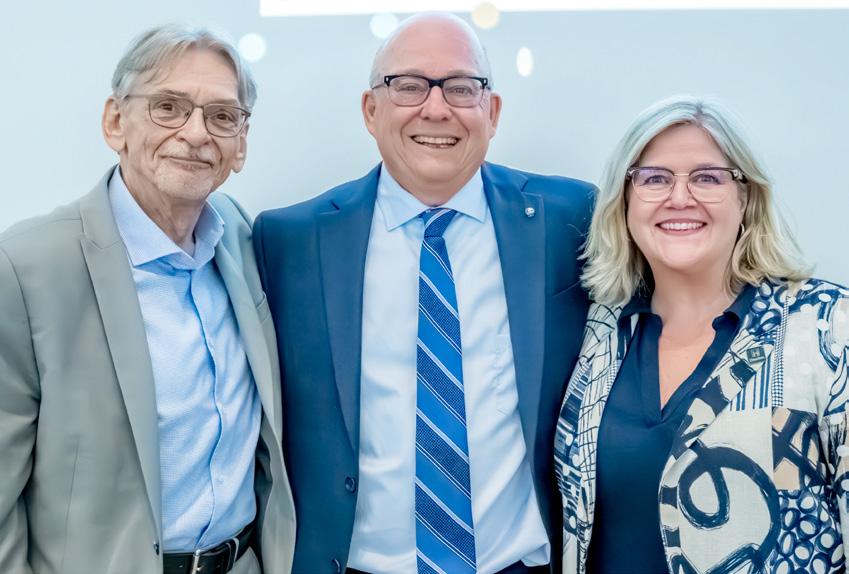


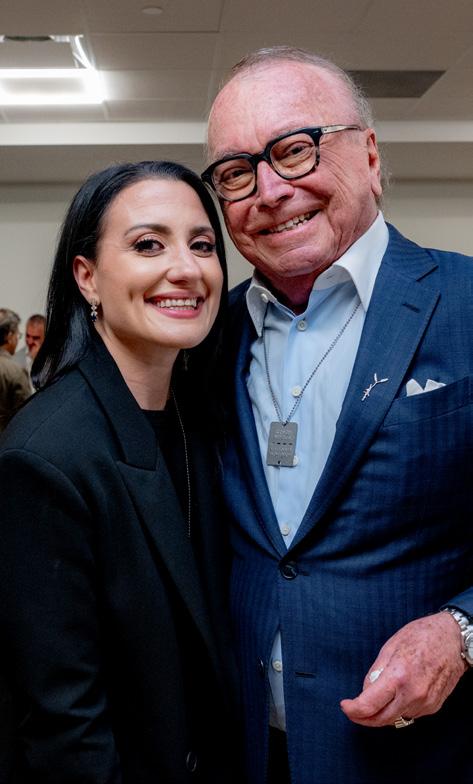

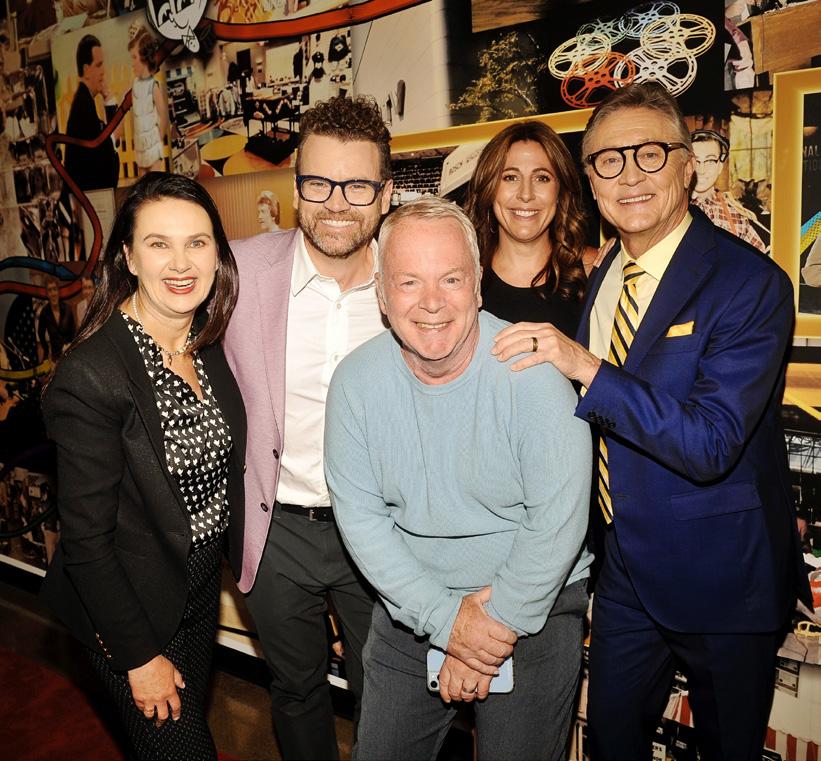
Terry Cooke and
Terry
9. Annette Hamm, Tim Bolen, Bob Cowan, Emily Vukovic and Brian Wood at the CHCH TV 70th anniversary celebration, CHCH headquarters, June 7.
10. Victoria Mancinelli and Tom Weisz (CEO, Effort Trust) at the opening of Margaret’s Legacy Holocaust Learning and Jewish Advocacy Centre, May 2. The centre is named after Tom’s mother. Tom, a noted philanthopist, died July

WAYSIDE HOUSE OFFERS RESIDENTIAL ADDICTION TREATMENT AND SUPPORTIVE HOUSING PROGRAMS TO MEN AND MALE YOUTH WHO ARE SEEKING SOBRIETY. ONE OF MANY SUCCESS STORIES, MATT IS FINDING NEW PURPOSE AFTER DRUG DEPENDENCY AND LIFE ON THE STREETS.
By KATHRYN DUNMORE |
IN THIS STORY, WE FOLLOW UP WITH MATT, WHOM WE MET IN A PREVIOUS HCM ARTICLE, FOCUSING ON HUMANITY, PUBLISHED A YEAR AGO. MATT LEFT THE STREETS TO START HIS RECOVERY PROCESS AND THAT JOURNEY INCLUDED WAYSIDE HOUSE OF HAMILTON, A NOT-FOR-PROFIT ORGANIZATION PROVIDING RESIDENTIAL ADDICTION TREATMENT TO MEN, AN AREA OF RAPIDLY GROWING NEED.
It looks like one of many homes in the downtown Hamilton area: old brick darkened by age, tall and solid. With four bay windows surrounding four white columns, its entrance is wide and welcoming.
Wayside House of Hamilton (Wayside) is much more than its structure. What’s inside makes it unique in all of Ontario. It offers ongoing, continual support for those who are recovering from addiction. In its way, it also offers a family.
Men from all walks of life come together under one roof for their common purpose of overcoming their addictions.
“At Wayside, we have guys who are homeless, we have lawyers, we have professional people, we have dads, and they come in from across the province,” says Regan Anderson, CEO of Wayside. “Once they come here, everybody is the same.”
Since 1967, Wayside has been offering hope to men struggling with addiction. A farm boy from Norfolk County, Anderson began working in addiction services in the 1980s. He obtained his master of clinical psychology in the U.S. but, upon returning to Canada, settled in Hamilton when he joined Wayside 25 years ago.
The program at Wayside focuses on the individual, tailoring a recovery plan that has the best chance of success. The recovery process requires taking a multitude of steps, assistance from community agencies and readiness to change.
“Our goal in the program is to pick up a client where he’s at, stabilize him, give him all the information he needs, and trust –(they) respect us because we respect them,” he says. “When it comes to identifying the barriers, if it’s psychiatric, we may want to work with St. Joe’s.”
If there are physical health needs or housing needs, those are addressed, too.
“Everything we do is from a trauma-

informed lens. We’re making sure this is a safe environment for people to land, catch their breath, with the skills to maintain their goal. We see some folks who may be struggling on the streets or encampments who need an opportunity to be assessed properly.”
Matt lived on the streets for 25 years. He struggled with his health as a child, but it was when he was a teenager that he became addicted to opiates.
“My appendix ruptured in my teens, and they gave me tons of painkillers then abruptly cut me off,” he says. “That’s basically when I went into my high school library and researched why I felt so shitty and found out it was dope sickness. From then it was on and off finding bits of painkillers here or there. Eventually your tolerance gets strong, so you move to heroin and then when heroin was replaced with fentanyl, I went to fentanyl.”
He called himself a functional addict. When he was in his 20s, he got a high-paying executive job in Toronto. But, when he lost his job due to company closures, his addiction eventually left him on the streets in Toronto before he returned home to the streets of Hamilton. It’s harder than one may think to
get off the streets, he says.
“Dehydration and regulating your body temperature is extremely hard,” explains Matt about living on the streets. “You’re either always hot or always cold and frequently dehydrated so you don’t feel very good pretty much all the time. The other thing that’s incredibly hard is you’re constantly being robbed of your belongings. If there’s anything to help the homeless epidemic it would be getting people a place where they can store some of their belongings, even as a temporary stop-gap measure. When you’re constantly losing your belongings, even if you have the courage and opportunity to get your act together, it’s impossible because you’re constantly in a vicious cycle of not being able to get enough clothing to apply for a job or apartment or to hang onto a cell phone so you can make and receive calls,” he says.
“Then mental health issues get exacerbated because you don’t sleep. People don’t generally rob you when you’re awake. Fentanyl and crystal meth are still abundant on the street and eventually those are the two drugs just about everybody gets led to at some point because crystal meth keeps you awake and fentanyl (helps you) to forget the
/continued on next page
situation you’re in and to not feel the pain and stress of it.”
Matt was portrayed in a Human Beings of Hamilton (HBOH) post in May 2023, accepting a tent and sleeping bags for himself and his spouse at the time. HBOH shares portrait photographs and stories of the backstories of those living on the streets on Facebook, while collecting and distributing items to make that life easier.
It was around that time that Matt decided he needed to change.
“It was shortly after Jack (Soule of HBOH) gave the tent to me and my spouse, I started to get sick of repetitively feeling like crap and having to panhandle to make money. I never committed crimes to support my habit. I just had a big sign that said have a blessed day or I had another sign that said have the best day ever but eventually I got sick of being sick all the time.”
He decided to withdraw from drug use on his own and immediately fell ill. He made his way to a hospital then stayed in detox for longer than usual.
“They actually made a special exception for me because they saw I really wanted to get sober and it takes longer than a few days to get into a rehab facility. Sometimes it can take months or even a year, so I stayed at the detox for about six weeks. I’m not exaggerating when I say fentanyl is such a strong opiate that it’s not like a few days (to recover).”
A counsellor at the detox centre used to work at Wayside and put in a good word as Matt’s determination to get sober was obvious to many.
“One of the biggest things about Wayside is the sense of community,” says Matt. “It’s the community that will help you to get sober and stay sober. You have the sense of community with the staff as well, so it makes you feel needed and wanted to be part of that community. What separates Wayside from other facilities is they prove to you that they’re serious with their lifetime aftercare. At anytime I can go to Wayside and have a bed for the night because I graduated from the program. It would simply take me making a call. They even pay for a cab for me to go there if I said I was worried about relapsing. So they really do focus on community as a solution.”
Currently, Matt is living in sober housing
The majori T y of people who are living in encampmen T s don’t really want to be there but there are reasons that will keep them there.”
r egan a nderson, C eo of w ayside
provided by Wayside. He is stronger in every way. Now, he gives back to his community, on the streets and off, while mending family relationships. He is even planning to return to school to become a social worker. Matt rightly credits himself for the fortitude to get sober, but he also credits his mother, as well as the counsellor at detox.
“If I had to pinpoint somebody besides myself, I would say it’s my mom who gave support when I needed it. When you’re ready, you have to jump on it right away. When somebody has the willpower to go through that painful process, it has to happen immediately, not like the next day or the next week, it has to happen when somebody is actually willing and ready to do it because it’s a really hard thing to psych yourself up to do.”
For 57 years, Wayside has been helping men through their addictions. Often, men return the favour by volunteering their time to help with programs or cook in the kitchen. Matt goes regularly to Wayside to cook meals.
Ryan Kitchen is program manager at Wayside. Growing up in Brantford, Kitchen said his panic attacks as a teenager led him to develop an addiction to alcohol. It eventually affected his physical health, forcing him into recovery.
“(I have an) intense understanding of how to deal with things not going your way,” says Kitchen. “My approach to recovery is one of mental, emotional, physical, spiritual
health, and developing and living a life where you’re whole. Obviously, it’ll never be perfect but you’re confident in your ability and feel like you have all the tools and all the skills necessary within you to be able to cope with the inevitable reality.”
Kitchen has been with Wayside for 13 years and has watched countless men recover.
“You learn things as a man, such as don’t talk about your feelings, don’t ask for help. All of those ideas are completely contradictory to what you need to do in order to be well,” he says. “We try to help these guys understand he may have added disadvantage purely (due to) certain man rules that he’s grown up with.”
Wayside’s philosophy of a continuum of care takes into account all types of human behaviour, including relapse.
“If he feels that he’s unsuccessful, such as he relapses later, I’m not to judge him,” says Anderson. “Same way I’m not going to judge my mother who had breast cancer. She went for treatment, then the growth is back, so she had a relapse. With her, we don’t blame the person because the cancer has come back. Why would you do that with addiction? Addiction and mental health are the same as any other form of health. We just label them differently. We’ll say the guy who’s using fentanyl in an encampment is doing so because he lacks so-and-so and he’s a loser and doesn’t care. That’s the furthest thing from the truth.”
Anderson says ongoing care is now more important than ever before.
“There is an increased number of people who are becoming opioid dependent and there’s an increase in people who are dying from overdose,” Anderson says. “There are more people who are using opioids than ever before. The need for success on a continuum has increased significantly. I stress the word continuum – we have to be there to support the client when the client goes to make a change. We have to curry the culture where change is possible and realistic and positive. That it gives you back everything you had lost. It gives you freedom, amazing freedom that addiction takes away from people.”
While community has proven beneficial for people living with addiction, even more so is the concept of promoting the possibility of change.
“The majority of people who are living in

encampments don’t really want to be there but there are reasons that will keep them there,” says Anderson.
“Addiction is one of them. I would never be grandiose to say stop using drugs and you won’t be in an encampment. That’s just foolish. But what we need to do and what we want to do is create a culture where change is possible.”
With decades of proof, men who thought their futures were bleak now have positive outlooks, successful families and work lives, and a new appreciation for support.
“It’s just rewarding to be there for someone,” adds Kitchen. “To create space for someone, connect with someone, give them the opportunity to really believe in themselves. You can physically see the light and life come on in someone’s eyes and it’s an incredible experience.”
Wayside offers several programs, such as a family program where loved ones are brought in to help understand addiction and help ensure success once the men leave Wayside. They also offer subsidized housing for those who want to live in sober-living
housing. A few men share a house, albeit with respective bedroom doors locked for privacy, living together like a family.
And it is a family – it’s been proven in court. Ron Tomblin is a realtor who procured six homes for Wayside House, which could then offer graduates subsidized and sober housing. He was cited by multiple officials for many bylaw infractions due to the living arrangements. They said it was a lodging house; Tomblin said it was a family situation. He even went to court to fight the infractions and won. All infractions were rescinded due to the recognition that these men live together as a family.
“What keeps me involved is that it really works for Wayside and, the best part of it all, it works for the guys,” says Tomblin. “These guys who follow the program, benefit from the houses and are very appreciative. There’s a personal satisfaction knowing I’m making a difference in the lives of these men.”
In the end, it all comes down to humanity and kindness to each other.
“When you are on the streets, the thing that gives you hope, and that for addicts will
lead to sobriety eventually, is simple acts of kindness by people who you don’t know,” says Matt.
“Somebody giving you a few dollars or a blanket or whatever, it makes you feel like you’re worth it. While I was on the street, I saw a woman who was crying, and I had my sign up that said have a blessed day and I smiled at her. A couple of days later she came to me to say that day she was on the way to the hospital as her daughter had just passed away and she was going to pick up her belongings. She was thinking about killing herself, but she said she saw me smiling there and she changed her mind. She wanted me to meet her son who she said she wouldn’t have seen again if it wasn’t for me. You never know what somebody is capable of doing and it’s simple acts of kindness between each other that helps.”
A major fundraiser for Wayside is its annual walk, Step Up for Wayside, which also provides a community for those who have loved ones struggling with addiction or have lost loved ones to addiction. This year’s walk takes place at Bayfront Park on Oct. 19. n









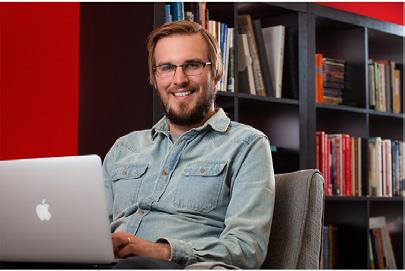
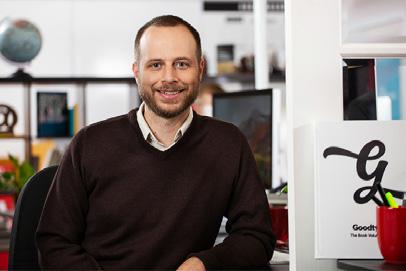







JONATHAN BROWN FOUNDATION IS HOSTING A GALA NOV. 9
RAISE
MEREDITH M ac LEOD
Claudia and Allan Brown are transforming their profound grief into action that will help other teens and families who are facing terminal and lifechanging illnesses.
The Browns lost their son Jonathan to Ewing’s sarcoma in 2021 at the age of 19.
He was their middle child – easy-going, athletic, smart and funny. His parents can’t quite comprehend his strength as he faced difficult and painful treatments while continuing his studies. He didn’t complain or get angry. He didn’t even allow himself to cry.
“I think we recognize that more and more, you know. When you’re living it, you just, you don’t even get a chance to breathe, you know, and then afterwards, you think, oh my gosh, he was incredible,” says Claudia.
Jonathan, Jonny to many, had begun a math program at the University of Waterloo but had to drop out when his cancer returned. He would have graduated this year.
In his honour, the Browns, who live in Carlisle, formed the Jonathan Brown Foundation shortly after his death.
In addition to offering scholarships for students facing
medical challenges, the foundation hosts fundraising sports tournaments and major galas. A first gala in 2022 raised an impressive $230,000 that helped to renovate the oncology unit at McMaster Children’s Hospital. Now, the foundation is planning Jonny’s Gold Ribbon Gala for Nov. 9, aiming to raise $250,000 for a teen room at the future Keaton’s House Paul Paletta Children’s Hospice in Dundas.
Ground has broken on that project, with a target completion date in 2026.
“Every given day there’s so many kids around here that are very ill or terminal. We want to do what we can to help,” says Allan.
“It’s in part about Jonathan and keeping his legacy alive, but it’s in part about enabling us to make something worthwhile out of this horrendous loss and help us get up every day,” says Claudia.
This is the only region in Ontario with a dedicated children’s hospital but lacking a hospice serving kids and teens. It’s estimated that up to 1,000 kids in this region at any given time could be in need of palliative care.
Contact jonathanbrownfoundation@gmail.com. n


MAIN STAGE REHEARSAL STUDIOS OFFERS A RANGE OF RENTAL STUDIOS AND PERFORMANCE SPACES FOR MUSICIANS AND PODCASTERS, WITH THE GOAL OF SUPPORTING ARTISTS AT ALL POINTS IN THEIR CAREER.
By MEREDITH M ac LEOD
Main Stage Rehearsal Studios is a beacon of nightlife in an otherwise dark stretch of Hamilton’s King Street East.
The funky co-working space for musicians and audio artists says it is “one of the largest rehearsal spaces in Canada, with the widest selection of studios to hold your next practice, jam session, recording project, audition, listening party, music video, podcast, dance session and other private events.”
Yes, a garage or basement will work for a rehearsal space, but it’s not ideal, especially for serious solo artists and bands, says Main Stage co-owner Justin Dobbin.
“The acoustics aren’t great and there are lots of distractions at home. Here, you are coming to work.”
Adds his wife and business partner Kelly Ng: “And we have everything they need here, whether it’s technical help, an extra amp or a cable or replacements for broken strings or drum sticks.”
Main Stage is a sprawling complex just east of Sanford Avenue in the Gibson neighbourhood that offers plug-and-play capabilities for local and touring solo artists and bands. The space had once been home to Rehearsal Factory, a now-defunct chain of rental studios in the GTHA.
When Dobbin and Ng took over, they built hourly rentals into their business model. There are even rooms geared to certain types of music, including metal, country and pop.
“We keep listening to what people want and need. We are willing to give things a try,” says Ng.
The couple says affordable rental and performance space is critical to the musical ecosystem of Hamilton, to support both aspiring and veteran artists.
“Music should be accessible to everyone and that’s what we try to do here,” says Dobbin.
Main Stage offers 12 hourly rental studios in two sizes that are equipped with a drum kit and professional-grade guitar and bass amps, PAs, and mics. The walls include double layers of insulation and drywall and heavy velour curtains to make for a sound-proof room. There are also ambient lights in every room and couches, stools and a mini fridge in the premium studios.
Rental costs begin at just $22 an hour for a

300-square-foot studio and $27 an hour for a premium space. There is a two-hour rental minimum and spaces can be booked via an online portal.
The ground-floor Live Room allows liveoff-the-floor recording, live streaming, and video recording or an upgraded rehearsal experience. Musicians use the space for album tracking, demo and sample recording, or to shoot promo videos for promotors and venue operators.
At 820 square feet, it rents for $37 an hour.
Main Stage also offers an on-site music store and equipment rental along with technical support to help with issues and to teach audio production to those who are interested.
The newest space is a dedicated podcast studio, which features plug-and-play simplicity for casual or professional users, including podcasters, voice-over artists, audio book recordings and other media production. Main Stage staff, which includes five full-time and three part-time employees, who are all musicians themselves, will train
new podcasters to do the technical work themselves.
Finally, there are 25 studios available for monthly rent that are booked by a range of local touring bands and professional musicians.
While rental hours are available from noon to midnight, 365 days a year, monthly tenants have access around the clock.
There are times every room is booked and the place really begins to rock after 6 p.m. The couple says about 120 bands come through the space in a week.
“There is a community of musicians here. Everyone appreciates and supports each other,” says Ng.
That’s critical to a booming music scene in the city, she says. There are many bands hustling to make it and they need the help of those who are succeeding.
“If everyone took the approach of the Arkells and helped other bands that are coming along, that’s really powerful.”
/continued on next page
The crown jewel at Main Stage is the 2,000-square-foot Showcase space, which holds full-sized events and rehearsals. It comes with a full backline, digital mixer, hazer, and a sound-activated stage lighting system. It’s available beginning at $55 an hour for rehearsals and $100 for events.
Main Stage hosts regular open jams in the space, giving many aspiring singers and musicians their first taste of a professional stage, says Ng. New bands and other forms of musical collaborations have resulted, too.
An experienced host studies each musician’s profile and preferences and helps to arrange jams, which are backed by a Main Stage house band and audio team.
“Our goal is to help people elevate their music,” she says.
That even goes as far as helping young bands market themselves.
“It’s not enough to put up a poster on Instagram or Facebook. It takes more than that,” says Dobbin. For one thing, it requires professional videos and recordings.
“We are confident in the experience we can offer a band. They can put on a great show here,” says Dobbin. “The gear is topquality. The speakers are the same they use at Scotiabank Arena.”
Having the full-sized venue is a big boost for Main Stage tenants, who have used it
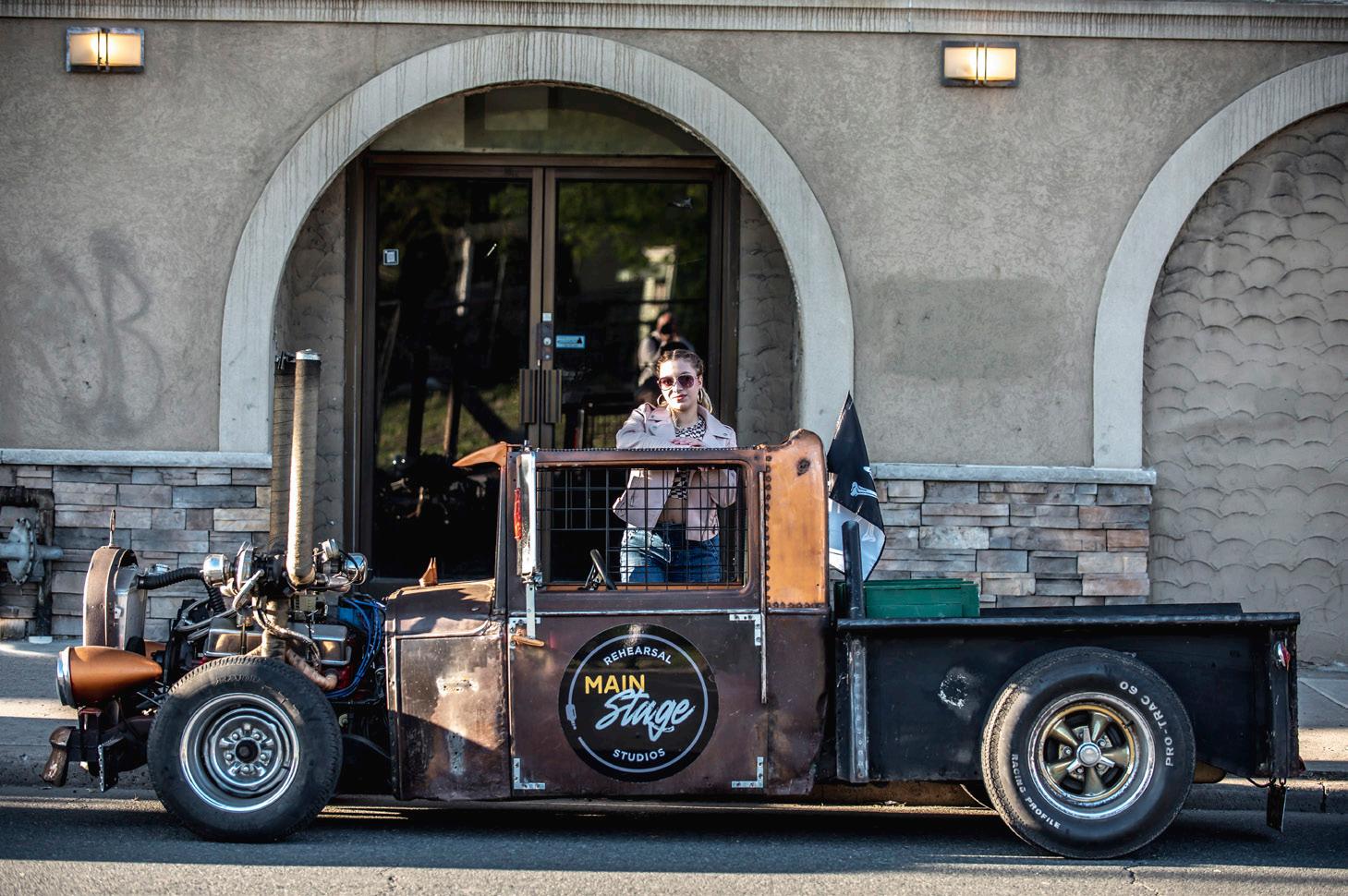
for concerts and listening parties. It’s been rented for salsa dancing, church services, for local orchestra rehearsals and for music development workshops hosted by the Hamilton Arts Council.
Drumeo, a popular online learning platform for percussionists, hosted a live workshop in the space.
One goal at Main Stage is to be a place kids can get a start in music. For that reason, open jams are all ages and no alcohol.
“If they could just put down their video games and cellphones and pick up an instrument …,” says Dobbin.

HAMILTON: ‘BEST POTENTIAL’
Ng and Dobbin bought the business in January 2022. He had been an employee at Rehearsal Factory for 17 years doing construction and maintenance. He had been working at the Hamilton location since 2016 but it closed in 2021, in the midst of the pandemic.
When the chance came up to buy the Hamilton assets, including all the music gear, the couple took the leap.
“We both felt Hamilton had the best potential and real estate prices gave us an opportunity,” says Ng, who is a chartered professional accountant. She gave up a job as a corporate controller for a Toronto private equity company and now handles all the finances and administration for Main Stage. Dobbin does all the construction and maintenance on the sprawling building and oversees the repair and upkeep of the equipment.
A Toronto location of Main Stage is operated by Dobbin’s best friend.
Ng and Dobbin moved to Hamilton with their now-three-year-old son in September 2023.
It ended Dobbin’s awful commute between Hamilton and Toronto and gives the family a new quality of life.
In 2024, the couple were named Young Entrepreneurs of the Year by the Hamilton Chamber of Commerce.
Main Stage is made up of three buildings together that total 35,000-square feet. It is
located in what was once a thriving stretch of King Street East. Much of the space was once occupied by Robert’s Restaurant and Swingin’ Door Tavern, a popular place for weddings and banquets from the 1940s to the 1970s.
Then it became Festival Banquet Centre. The now-demolished Strand Theatre was just a few doors away.
Ng and Dobbin hear from lots of people who attended weddings or banquets or played shows in the space, including famed local guitarist Bill Dillon, who played his first show at Robert’s.
There are many reminders in the lobby of the building’s life as a former banquet hall, including large mirrored walls and big statues. The ground floor was in rough shape so Dobbin’s construction skills came in handy. The walls around a winding staircase up to a mezzanine on the second floor along with the lobby space feature large-scale portraits of famous musicians painted by local artist Natasha Rose. Dolly Parton, Michael Jackson, Bob Marley, Johnny Cash, Snopp Dogg, Freddie Mercury and Prince are among the immortalized icons.
There are other creative touches everywhere, including lights in the Live Room that Dobbin made out of snare drums.
At a recent open jam, musicians and singers jump in and out of performances of “Ain’t No Sunshine,” Gnarls Barkley’s “Crazy,” and “The Weight” by The Band.
One of the singers is Emma Bown, a Hamilton singer-songwriter who has rented
studio space to rehearse, record and make videos.
“We are just teenagers and we get access to a great space at a really friendly price. We get set-up help, so the sound is great,” says Bown, who is studying music at Western University and performs under the name Emerald B.
Musicians are asked to sign up for the open jams ahead of time so a lineup can be assembled but some just show up and that’s OK, too. There is a varying level of talent and comfort on stage but everyone is treated the same.
Ng describes the jam as a “musical playground.”
Jack, a nine-year-old drummer in a leather jacket, climbs behind the kit. He lays down a drum beat, a bassist from the house band joins in, and soon there are two guys freestyling at the mic, along with a trumpeter and saxophonist. Jack holds it all together before breaking into a wicked solo.
Turns out Jack has travelled from King City. He’s only been playing drums a few months but he’s as cool as a cucumber on the stage.
Isaiah Ahmad is a member of the house band and helps to host the open jam. He’s frequently dancing, while playing bass, guitar or trumpet and helping to lead the assembled musicians.
He learned about Main Stage through rehearsing with his ska band The Checkerboards, a six-piece ensemble that just released their first song.
“There is nowhere else like this. I live in an apartment. I can’t jam there. It’s just fun to come here and do that.”
Hamilton is home to a lot of young people who are musically talented but lack confidence to get on a stage, says Ahmad.
“Here, it’s not just about how the music sounds but getting over that shyness.”
Andy Baker, who plays in a ’90s cover band called The Channels, jumped up to play a song or two at the open jam. His band frequently rehearses at Main Stage and hosted their first event there, a show in March to raise money for CityKidz.
“The people who run this place are amazing. It’s just a great place for local musicians to meet up. When I was growing up, I would have killed for something like this. It’s a sensational space.”
Baker is a Hamilton native, who left for Toronto but has now returned to his hometown.
“It’s so hard to get live experience playing in front of people because there aren’t a lot of venues around anymore. That first gig goes so much smoother when you have that experience.”
Mickey DeSadist, singer and founding member of punk pioneers The Forgotten Rebels, is a big fan of Main Stage. He has popped in to see the open jam after a long ride on his bike.
“I performed at one of the first open jams. I played “Brown Sugar” in open C, the way it was originally done.”
The Forgotten Rebels, which are performing on Sept. 27 in Victoria, B.C. and Sept. 28 in Vancouver, rehearses at Main Stage.
“I wish it had been around forever. I wish it was here in the ’70s,” says DeSadist. “Room 12 is our favourite place to rehearse.” n




DEJEHAN HAMILTON IS USING HIS KNOWLEDGE AND EXPERIENCE TO LIFT UP OTHER RACIALIZED MUSICIANS AND HELP THEM NAVIGATE THE INDUSTRY.
By MEREDITH M ac LEOD
It’s well known that music is a tough way to make a living, so a 12-week program called The Blueprint is aiming to make the road a little easier for racialized artists.
The Tune In Foundation has now graduated two cohorts of students – 18 altogether – who learned from a roster of mentors in the industry.
Dejehan Hamilton is the face and the knowledge behind the Tune In Foundation. He’s a veteran steel pan performer under the stage name Luckystickz but also a music management graduate who wants to guide other musicians setting out on a career.
“I’ve learned what to do and what not to do and I love sharing that with others,” he says. “So many artists don’t want to deal with the business side of the business but they need to know it.”
Hamilton is a multi-channel artist. He’s a performing drummer, a songwriter, a motivational speaker, an author, an emcee, a consultant, and runs a media production company called Tune In Media. He says people think the job of a musician is to show up to performances but there is so much more behind the scenes – networking and hustling for gigs, rehearsal and preparation, getting contracts signed, and managing schedules among them.
Hamilton found his passion in sharing his knowledge and supporting BIPOC artists through the Tune In Foundation, he says. Its programs include summer camps for kids through An Instrument for Every Child, a bursary through the John C. Holland Awards, and the Talk To Me Nice (TTMN) Conference, which aims to amplify the voices and talents of racialized artists.
Hamilton brings musical presentations to local and youth empowerment workshops to combat problems such as bullying, low self-esteem, and lack of educational success to underserved inner-city schools. Tune In Foundation also works with Global Youth Groove to deliver workshops and musical instruments to children in Kenya.
Hamilton is the first and only steel pannist to attend and graduate from the Berklee College of Music in Boston on scholarship, earning a music management degree. In his pursuit of a career as a solo artist, which included studying at Mohawk College, he has built a large network of industry people that he calls upon for The Blueprint.
Hamilton was born and raised in North End Hamilton. He was raised by a single mother in a low-income household. Music was both his refuge and his opportunity. He started playing in church at five years old and went on to play in the Hamilton Youth Steel Orchestra.
Hamilton, who is dynamic and charismatic and believes success is rooted in mindset, has found important community partners to support his work. Main Stage is a symbiotic partner with the Tune In Foundation. Hamilton connects to aspiring musicians through the venue’s open jam nights, Blueprint participants take advantage of fully equipped music studios, and use it as a stage for its hART Music Series concerts.
For Main Stage, graduates of The Blueprint can turn into future tenants.
Hamilton built The Blueprint – offered free to participants – after securing the Hamilton Arts Council’s support for the program. Along with deep dives into what it takes to succeed in the business and marketing lives of a professional musician, it also includes a styling and aesthetics session, vocal and stage
“You can’t just stand in front of a mic and sing. You can be talented as hell but it’s so much more than that.”
Cruicks, whose influences include funk, soul, gospel and old-school reggae, says the program has given him a community of peers that are willing to help each other.
“I just had to get over myself and realize I don’t have to do it alone.”
Blueprint participants get exposure to mentors, including music executives, fellow artists, brand and marketing experts and recording engineers. Each session is held in a studio at the Main Stage Rehearsal Studios. When it’s over, four graduates will be chosen to perform at the Hamilton Arts Council’s hART Music Series and one will get to take the stage at Sonic Unyon’s Fresh Up Festival.
But first up is business.
There is a lot to learn – HST numbers, structuring and registering a business, and protecting your brand and work – and that /continued on page 54

CHCH
By MEREDITH M ac LEOD
When CHCH-TV took to the airwaves from Hamilton on June 7, 1954 as a CBC affiliate, only about 20 per cent of Canadian households had a television set. That number ballooned to 80 per cent by 1960 and has climbed ever since.
And also ever since, the history of CHCH has been tightly interwoven with that of Hamilton and generations who grew up here (and well beyond), know the station as a cultural icon in the city. The station’s media personalities became household names over the years – Tom Cherington, Dick Beddoes, Connie Smith, Dan McLean, Paul Hendrick, Matt Hayes, Ken Welch and Annette Hamm among a much longer list.
Bill Lawrence, Steve Smith and Don Cherry became stars at CHCH and Martin Short even made his debut on the station.
CHCH was among 17 stations in the country to go live 70 years ago.
But in 1961, the station became the first, and was for over a decade, the only television station in Canada not to be affiliated with any network.
Fast forward to today, an era where local stations have been swallowed up by networks or closed entirely, CHCH is the longest-running independent station and among just a handful of unaffiliated outlets left in Canada.
And the fact its parent company Channel Zero is investing in local news, adding news shows and podcasts, hiring journalists and recently invested in a large new headquarters is virtually unheard of these days.


CHCH moved into its new space on Innovation Drive in Waterdown in April 2022. It offers all the cutting-edge elements of modern studios, including a 360-degree anchor desk with fully adaptable lighting, a “Gate 11” sports desk constructed in the style of Hamilton’s Tim Hortons Field, a triplemonitor backdrop featuring a stylized skyline stretching from Toronto’s CN Tower through Hamilton City Hall to Niagara Falls’ Skylon Tower, another 12-monitor backdrop, and a portable control room to allow CHCH-TV to produce live on location for special sporting events and concerts.
Nods to the station’s history are everywhere – from a Hamilton Spectator front page in the green room from when the station launched in 1954, to the paper maché vintage mascot head dubbed Mr. 11, to a sprawling mural that pays tribute to the station’s many personalities and milestones.
“We built this building from scratch during the pandemic,” says Channel Zero marketing manager Nick Bannard.
“Other newsroom were shrinking and people were being let go. This could have been abandoned but ownership carried on with it.”
When CHCH made the move from its Jackson Street West location in downtown Hamilton (now being developed into the 31-storey Television City condos), the station bid goodbye to its longtime home. The silver-wrapped TV studio that opened in 1983 – fondly nicknamed “Spaceship 11” at the corner of Caroline and Hunter streets –is now demolished. (The 172-year-old stone Southam House on the site is incorporated in the condo plan.)
From the Spaceship and the now-boarded up CHCH Telecentre on King Street West, CHCH produced untold thousands hours of local news, sports and entertainment programming, including Tiny Talent Time, professional wrestling, comedy show Smith & Smith, and Don Cherry’s Grapevine. But shifting from analog to digital broadcasting requires robust fibre optics and open access to the skies for satellite signals and transmission towers. And parking was a worsening issue for employees.
At the new suburban headquarters, employees now work in an open-concept, grouped desk environment with splashes of

colour and sleek indoor and outdoor kitchens that double as dining spaces and sets for cooking segments on CH Morning Live
Tucked into a corner of the newsroom is a futuristic-looking Loop booth, which offers a sound-proof space for reporters to do interviews or just grab some silent time. In another recording booth, reporters can record the voice-overs for their news reports.
The new space allows for collaboration and multi-channel news content production, from email newsletters to podcasts, and from streaming from a YouTube page to traditional TV broadcasts, says Chris Fuoco, Channel Zero’s executive vice president of sales and marketing.
“We have a remarkable number of people that live stream our morning show every day. And I suspect a number of them are doing it on the GO train while they’re commuting. You couldn’t do that a few short years ago.”
The station celebrated its 70th birthday on June 7 with a party attended by many employees past and present and guests.
“We wanted to reward staff and alumni and celebrate them being a big part of the legacy of such a great brand, reward viewers for making us part of their daily lives, and reward advertisers for supporting their local station,” says Bannard.
The party kicked off a 52-week celebration, says Bannard, that has included a live studio audience drawn from contest winners for a

CH Morning Live show.
“These were the biggest CHCH fans you could ever come across,” says news director Greg O’Brien. “It was amazing on a level I still can’t articulate. These are people who love us and appreciate us.”
A panel in May included numerous current and former CHCH journalists and technical staff sharing stories from past decades and insights into how the media has changed. Segments have been aired ever since and the event will be packaged into an hour-long special.
Other birthday elements include a special commemorative Top Story beer by Lake of Bays Brewing and a memorabilia deal with True Hamiltonian to sell official station gear. /continued on next page
There isn’t a media outlet around that hasn’t endured tough times and CHCH is no exception. It has gone through a number of ownership changes, a bankruptcy and the prospect of going black for good.
In the 1970s and 1980s, CHCH was one of the country’s most prominent syndicators of Canadian content, with many of its locally produced entertainment programs airing on television stations across Canada and occasionally internationally.
CHCH’s over-air signal was available to much of Ontario and in 1982, it became a superstation, providing its content to cable television providers in remote regions of the country that otherwise only had access to the CBC.
In 1990, Western International Communications bought CHCH and rebranded it is ONtv. With that shift, Hamilton took a back seat and ratings suffered. When Canwest bought WIC’s assets in 2000, the station was once again rebranded to CH. Soon after, Canwest entered a national and provincial licensing deal with the E! cable network in the U.S.
CH’s non-news programming became E! Ontario.
In February 2009, Canwest announced it was considering the possible sale or closure of CHCH and the company’s other stations in the E! system. In response, a grassroots group fronted by then-CH personality Donna Skelly announced its intent to purchase the station and return to its local focus.
Canwest then revealed in its licence renewal application that CHCH was projected to lose nearly $30 million during the station’s 2010 fiscal year. On June 30, 2009, specialty channel operator Channel Zero announced that it would purchase CHCH and CJNT-TV in Montreal from Canwest in exchange for $12 in cash and the assumption of liabilities.
Channel Zero formed in 1999 and when it acquired CHCH a decade later “it was kind of a David and Goliath thing,” says Fuoco, who also co-owns Channel Zero along with Cal Miller and Romen Podzyhun.
“We were a small broadcaster prior to that and then we absorbed a very big and very important television station into our little fold … We put our brains together and started looking at this fantastic opportunity in Hamilton. I think a lot of other broadcasters had lost sight of just how fantastic a station
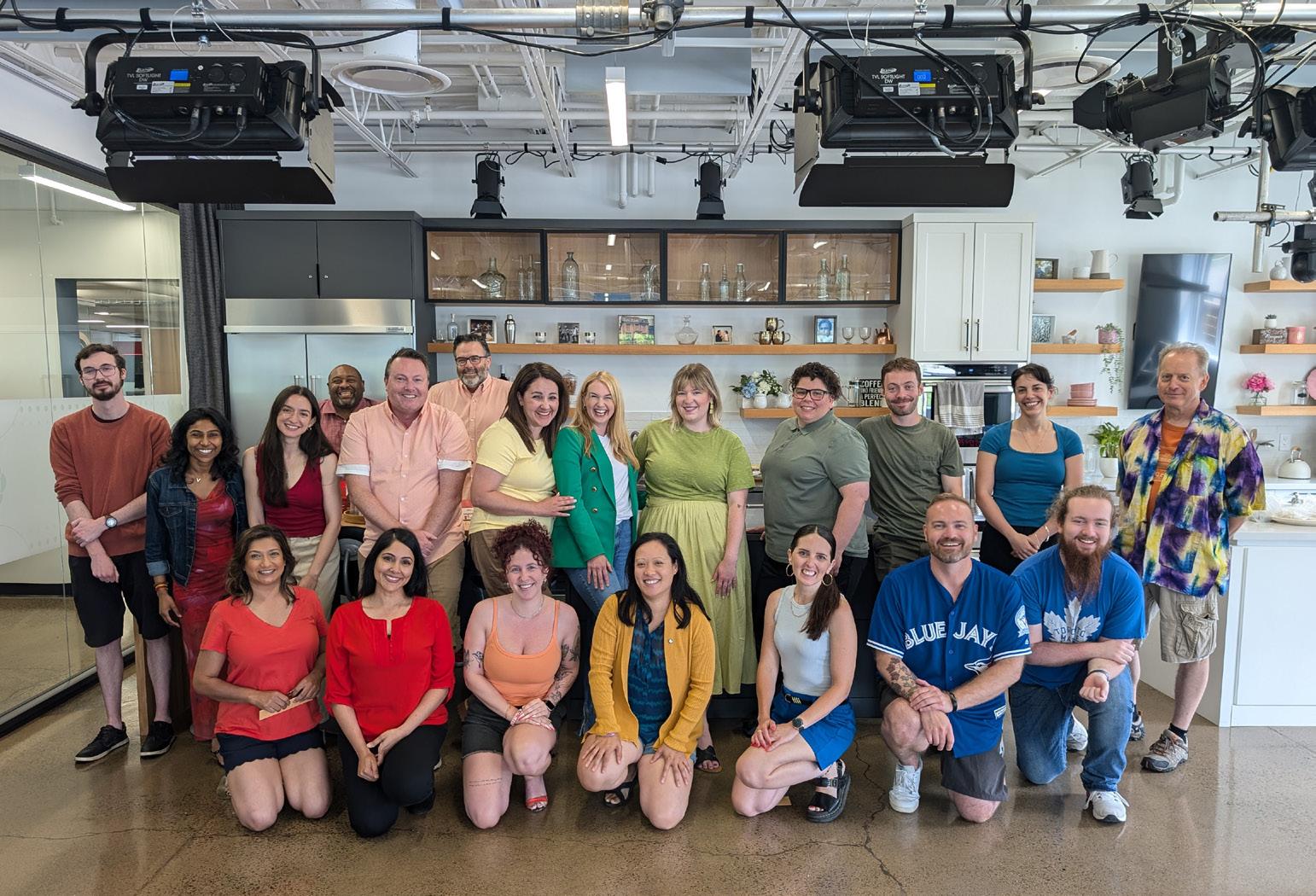

hamiltoncitymagazine.ca
CHCH was. We said, well, let’s see if we can figure it out and find a way to save the station.”
Almost immediately, Channel Zero moved to reinstate the CHCH branding, including the vintage colourful logo that is reminiscent of a television. Its initial programming consisted of local newscasts throughout the day and movies at night. In 2010, it began airing American network television series in primetime and made some modest additions to its local programming.
“We said that instead of running away from local and everything that’s made CHCH great for 55 years at that point, we need to dive right back into it, head first, and that’s where we were successful,” says Fuoco.
But that success hasn’t come easily. Trouble surfaced again one afternoon in December 2015 when Channel Zero abruptly ended its rolling news format and announced that Channel 11 L.P., the subsidiary that had produced CHCH’s newscasts since 2009, had filed for bankruptcy. Company executives said the station was not shutting down but that a major restructuring of its operations was imminent.
CHCH’s news output was slashed from 80 hours a week to 17.5 hours, including a morning show, newscasts at 6 p.m. and 11 p.m. and no weekend news.
With that devastating news, 167 people lost their jobs. The story is legendary in media circles. Staff were summoned to one of two rooms. One group was told their jobs were finished. The other group – 71 people – were offered new jobs.
“Those layoffs are still part of the story here,” says O’Brien. “And challenges still exist. National ad sales are soft but local ad sales are good. There are lots of people who believe in what we do and how we can help them reach our audience.”
CHCH is Channel Zero’s only broadcasting asset. (Montreal’s CJNT in Montreal was sold to Rogers in 2012 and is now part of the Citytv network). The company owns a film production and distribution arm, six specialty channels, including Silver Screen Classics, Rewind, and adult entertainment channels, and digital film distributor Ouat Media.
It also launched Junction Digital a few years ago that creates digital campaigns for local clients including podcasts, newsletters, social media content and videos.
O’Brien was founder of trade publication Cartt.ca, which covers the telecom, cable and television industries. He sold his stake to take on the news director post at CHCH in 2021, his first time running a newsroom.
“I’m a news junkie and an industry junkie. This is a great fit for me. I love this region so much and I have always been a huge fan of CHCH,” says O’Brien, who moved to Hamilton in 1994.
“People have relied on this station for decades and we are so proud of that.”
He oversees four news shows in the CHCH lineup: CH Morning Live, news broadcasts at 6 p.m. and 11 p.m., and Trending Live, a popular news talk show that covers local, national and international stories.
“We serve Hamilton, Burlington, Oakville, Haldimand-Norfolk, Brantford and Niagara. That’s 1.5 to 1.7 million people. It’s a welcome challenge to stay on top of what’s important to our viewers,” says O’Brien.
Altogether, CHCH brings in 2.4 million viewers a week and many more access news through livestreaming or CHCH’s various social media channels.
The diversification of platforms reaches new audiences but also allows advertisers with smaller budgets to access CHCH products.
O’Brien acknowledges the ongoing challenges of being in local media and having to do more with less. (During the writing of this story, news breaks of another devastating hit to the media landscape – the sudden loss of 900 CHML.)
“We have to focus on the role we serve in informing the public. Journalism isn’t a job, it’s a calling. It’s also a fun way to make a living because you’re telling stories and making a difference.”
About 40 people work on the news side at CHCH, along with about 35 people in operations.
“Some people cross all four shows in some way. Cross-collaboration is very common here,” says O’Brien.
Technology has streamlined the reporting process and journalists are cross-trained, too. They can work as reporters, fill in as anchors and get behind the microphone on a podcast, says Fuoco.
All of that allows for flexibility and maximizing a small team, he says.
It’s basically a 24-hour operation. An early editor arrives at 1 a.m. to sort through what’s happened overnight and get to work on the news lineup for CH Morning Live. Anchors Annette Hamm and Tim Bolen and show producers start at 3:30 a.m.
From there, the day takes off, with the

digital team, web writers, and reporters, producers and editors for the news broadcasts. There are several meetings throughout the day to make sure stories are coming together and to adjust plans when they aren’t.
About a year ago, CHCH started producing podcasts, including Sportsline with long-time sports anchor Bubba O’Neill and Newsmakers, which checks in with local politicians, artists, sports figures and journalists.
“We know that our audience wants to access information in a variety of ways, so we are focused on diversifying our platforms and widening the net for consumption,” says O’Brien.
In a time of newspapers closing down, Channel Zero is breaking in there, too.
The Brant Beacon, serving Brantford, Brant and Six Nations, is now three years old. In that time, the digital platform has produced 3,500 stories, some in collaboration with CHCH journalists.
“We can’t get to every story but these smaller local stories, like what’s happening at the library or a charity bake sale, they matter to their communities,” says O’Brien.
Channel Zero is growing the platform,
/continued on next page

and O’Brien, who worked as a consultant on the Beacon before taking his current job, says the plan is to bring the model to other communities.
“We are pretty proud of what we’ve done there in a short period of time,” says Fuoco. “We’re always evaluating and looking at opportunities. I mean, that’s the nature of an entrepreneurial business, which is kind of in our DNA. That’s what drew us to CHCH, and we saw that as an opportunity, when maybe others didn’t.”
While Fuoco wouldn’t close the door on producing a drama or comedy, that carries risk in today’s market. Channel Zero is focused on what it does well.
“In the ’70s and ’80s, you flipped on the TV and you had maybe four or five options or if you had a cable subscription or a powerful enough antenna, you might be able to pick up a couple of stations out of Buffalo. So, an independent station in southern Ontario could stand out in that market and grab an audience. Fast forward to today, and between, a 200-channel television subscription world,


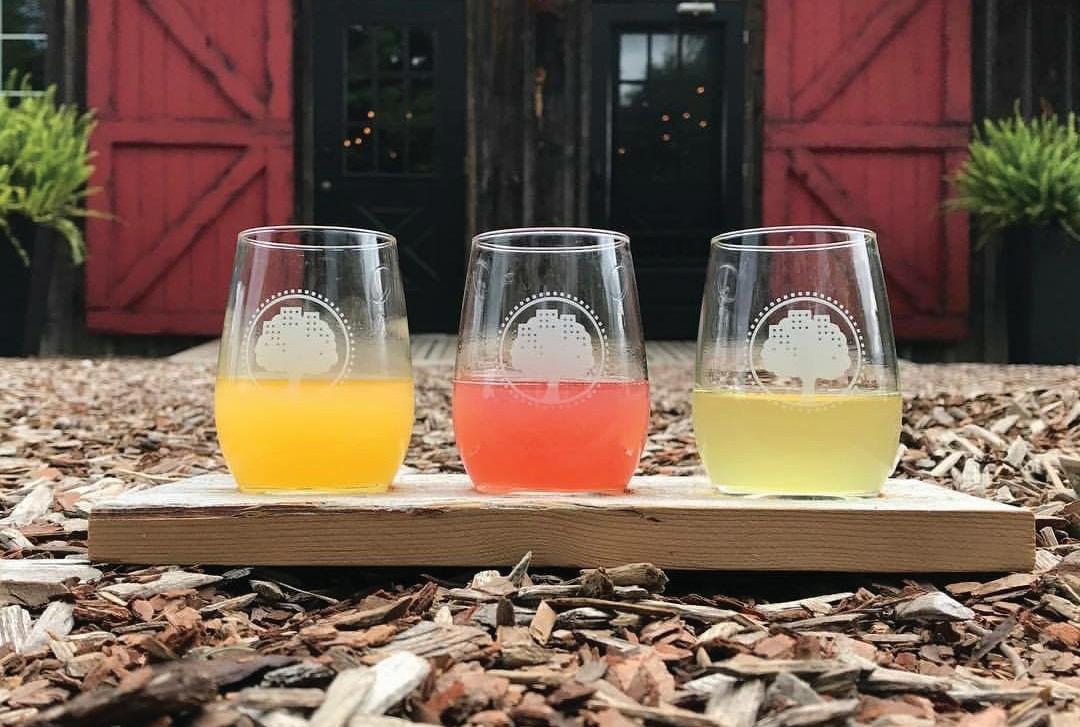
everything that’s available on the internet, countless number of streaming services, there is a lot of competition for your attention.”
The key is finding a niche that sets you apart, says Fuoco. For CHCH in 2024, that’s local news and news talk, movies, primetime simulcasts of U.S. programming, and a daytime retro block of classic comedies and dramas (I Love Lucy, Dick Van Dyke, The Love Boat, Dynasty among them) that Fuoco calls comfortable favourites.
“There was immediate traction with that. People started asking for other shows. The outpouring of suggestions from our audience was great, to the point where we’re retro programming from basically 10 o’clock in the morning until 5:30 at night. It’s found a nice, loyal audience and stands us apart from other broadcasters.”
If there’s one thing that’s clear over 70 years, it’s that when Hamilton’s station has strayed from its local focus, it has lost its way. From the weather, to high school sports to municipal politics, local still rules, says Fuoco.
“CHCH is a place to see the community, to
see businesses, to see restaurants and fun events and festivals and theatre and sports. It’s a place for people to see their community, and that’s what the station’s always done, I think, and I don’t think that changes in the 70 years ahead of us.”
For his part, O’Brien believes that being a trusted source of news will only grow in value. As local media outlets covering city hall, police services and other civic institutions disappear or drastically shrink in size, experts predict that as much as 90 per cent of content on the internet by the end of 2025 will be generated with the help of artificial intelligence.
“Generative AI is going to make a mess of the internet and people won’t know what is real and what isn’t unless they seek out credible media sources,” he says.
“Every day, we ask questions and seek out the facts and try to find the truth. So I think in the future, CHCH will hit its stride even more than it does now. All we can do is to keep doing what we do and prove our value every day.” n




ARTS AND CULTURE IS SPONSORED BY TOURISM HAMILTON
RENOWNED CONCERT PIANIST WILL PERFORM A RECITAL AND SHARE STORIES AT A CONCERT HOSTED BY THE MCMASTER UNIVERSITY LIBRARY AND ARCHIVE ON OCT. 17. By meredith m ac leod
Valerie Tryon’s sight may be diminishing, but the internationally acclaimed classical concert pianist doesn’t need sheet music. She has a vast repertoire committed to memory.
That will be on display when Valerie Tryon performs a recital in honour of her 90th birthday, which was Sept. 5.
The concert will feature an extended conversation with 96.3 FM Classical Jukebox host Daniel Vnukowski, interspersed with performances by Tryon of pieces she has chosen to highlight eras of her eight-decade career.
Choosing the music is proving a challenge, she says during our interview in mid-August, but she knows works by Liszt, Chopin, Ravel and DeBussy will be included.
The concert is being hosted by the McMaster University Library, which has also commissioned a portrait of Tryon by Lorne Toews of Dundas. It will be unveiled at a reception after the concert and will hang in the foyer of the Ancaster Memorial Arts Centre. where the concert is being held.
Tryon’s list of accomplishments and recognitions is long and includes an honorary doctorate from McMaster upon her retirement as associate professor and artist-in-residence in 2000.
She is now a music teacher and artist-in-residence at Redeemer University.
At a tribute concert in honour of Tryon’s donation of her archives to McMaster in 2016, the late renowned conductor Boris Brott said: “Valerie is a consummate musician in almost every form. She plays with such perfection, that I think that’s why the word ‘incomparable’ is truly the right word to describe her.”
Tryon came to Hamilton from England in 1971.
She talked to HAMILTON CITY Magazine alongside her sister Jacqui Muir who, like Tryon, lives in Ancaster. Muir and her family moved to Canada in 1976 and that greatly eased Tryon’s battle with homesickness.
“I’ve been very fortunate, because without them, I can’t imagine what my life would have been,” says Tryon. “I’d have been very lonely over here by myself. Although I made a lot of friends here, which I value very much, but it wouldn’t be the same as not having my sister and her

children and everybody.”
Tryon says she isn’t much for celebrating her birthdays.
“I hate getting old. I hate it. When I was 20 and 21 I was quite happy to have a birthday but not since then,” she says.
But she’s excited about the upcoming concert. “I am grateful for it and I will do my best to make it interesting.”
Tryon has no trouble with her hands despite a fall a couple of years ago on ice that broke her wrist and required her to work out new fingerings to adapt to a shortened range for that hand.
But her sight is not good, making reading music difficult. Remarkably, there is 80 years’ worth of music in her memory.
“Whatever you ask her to play, you know, she can play it because it’s all there,” says Muir. “It’s so incredible. I can’t remember my shopping list but she has all this music in there.” n
GUITARIST, SONGWRITER AND PRODUCER CHAMPAGNE JAMES ROBERTSON IS A NEWCOMER TO HAMILTON, NOT TO MENTION ONE OF THE CITY’S BUSIEST MUSICIANS. By KERRY
DOOLE
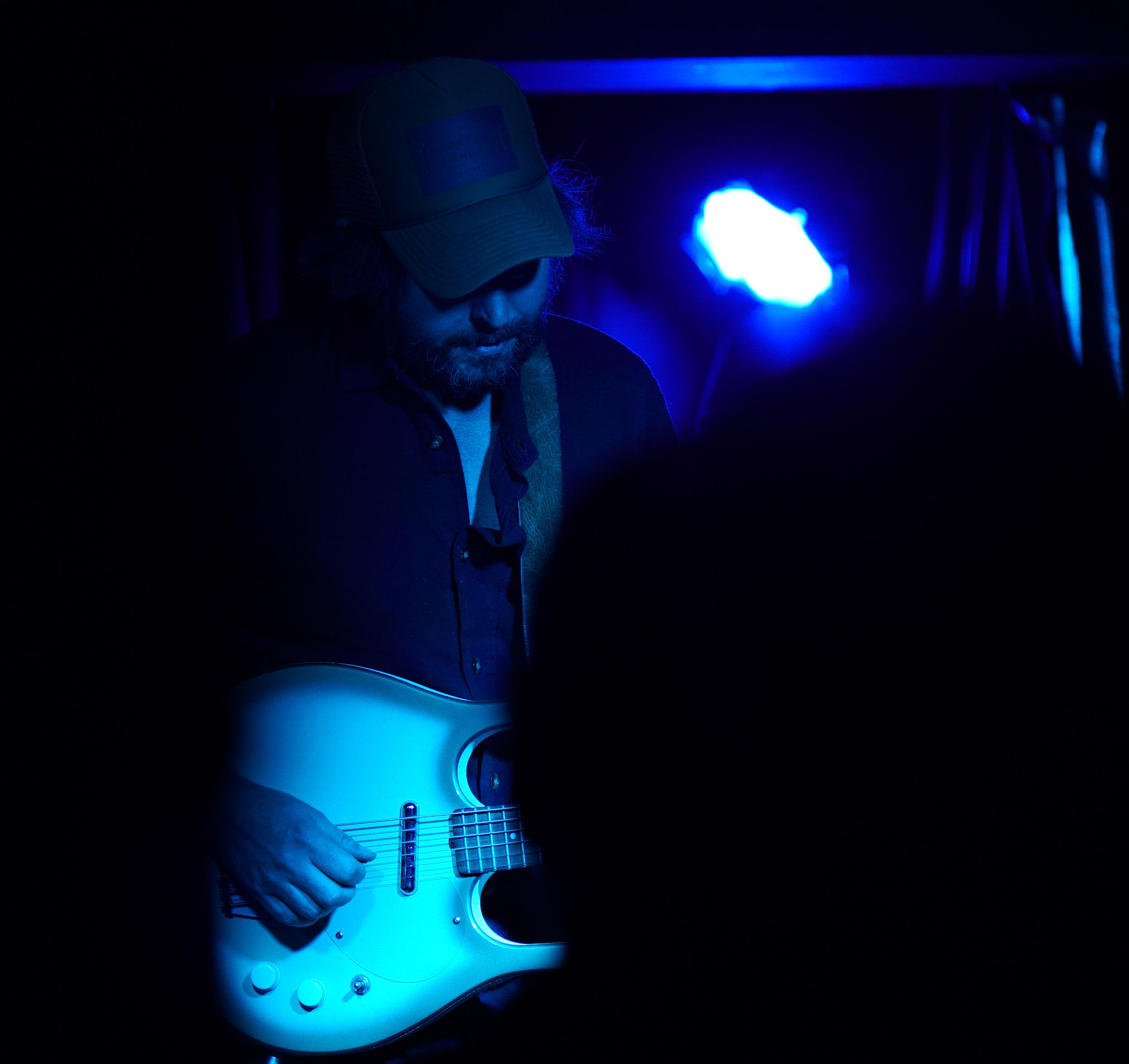
When Champagne James Robertson relocated to Hamilton from Toronto just over a year ago, this city’s music community instantly got stronger. He is a triple threat, as a guitarslinger of rare skill and range, an eloquent songwriter and a tasteful producer, and his talents have long been in demand in Toronto, Hamilton, Nashville, and beyond.
His current work priorities are four very musically different projects. These comprise the fiery rock ’n’ roll of Hammer heroes Junkhouse, the moody folk-rock of MOONRIIVR, the stylistically eclectic coverband phenomenon Dwayne Gretzky, and the originals Robertson writes and performs with his instrumental trio. That list testifies to the versatility of his instrumental and compositional prowess.
Robertson cut his musical teeth on the Toronto scene from the early 2000s, first with the band Run With The Kittens, playing at the Cameron House every Tuesday for 10 years. (Champagne is a nickname bestowed by those bandmates, referencing his bubbly personality). He was also a member of Elvis Bossa Nova, and noted roots-rockers New Country Rehab, with whom he recorded two albums. He also played on albums by such artists as jazz artist Brandi Disterheft, honkytonk star Lindi Ortega, Treasa Levasseur, Quique Escamilla, Tim Armstrong of Rancid, Ferraro and more.
HCM recently chatted with Robertson over coffee at The Cannon on Ottawa Street North, not far from his east Hamilton residence. We learned that Hamilton has long been on his radar as a possible base, thanks to strong personal and musical connections developed over the past 15 years.
High on that list is close friend Colin Cripps (Blue Rodeo, Crash Vegas), with whom Robertson has made three records as surf instrumental combo C&C Surf Factory. “Colin’s DNA is Hamilton, so I’d always hear about it. I rather romanticized it and other blue-collar cities like Manchester and Detroit, all incredible music cities,” he notes.
“Colin has been such a mentor, teaching me so much about the sound of guitar in a classic sense. He’s such a thoughtful guy, and a deep well when it comes to guitar and to Hamilton, two things I’m curious about.”
Cripps (who now lives in Toronto but spent
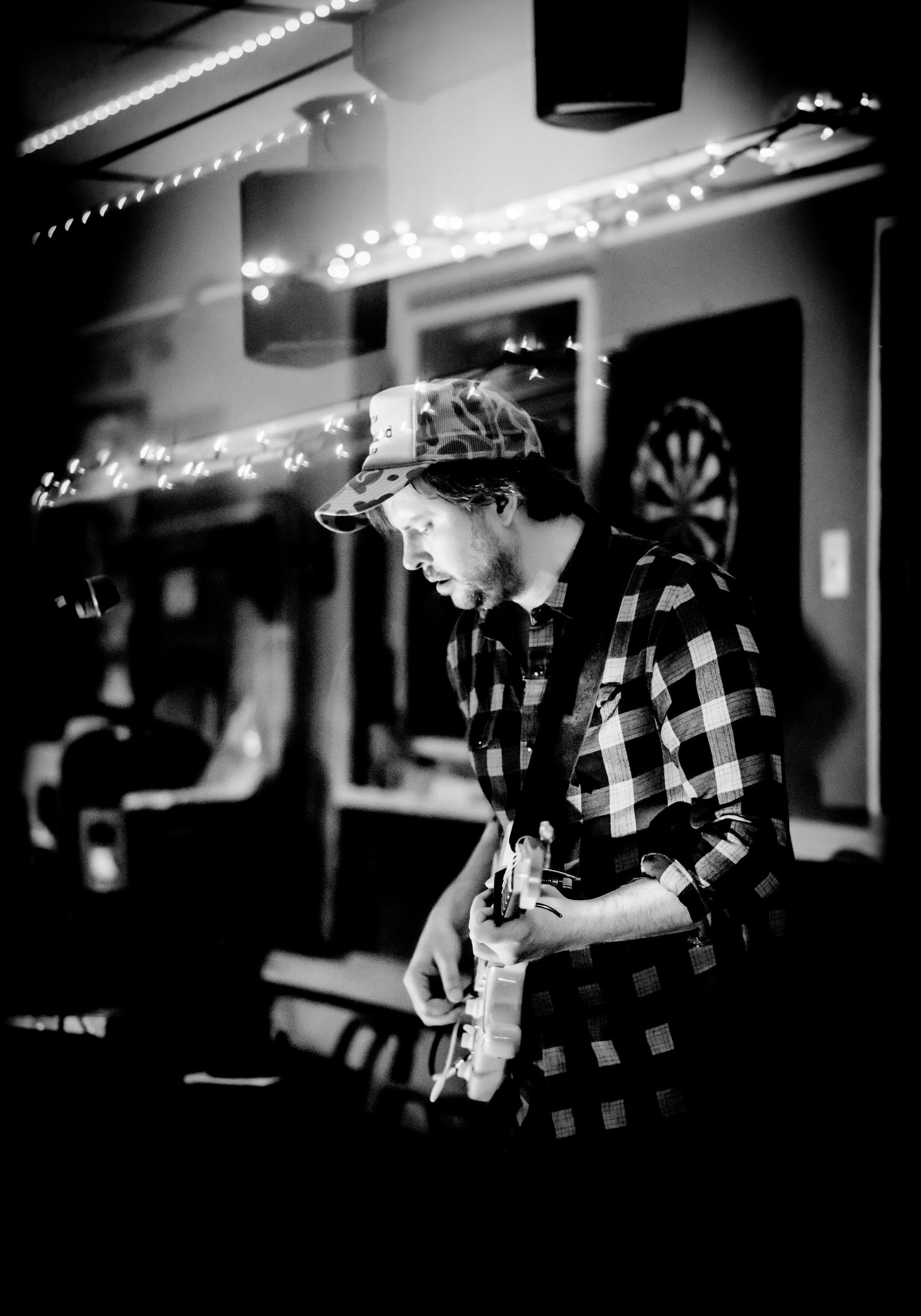
most of his life in Hamilton) tells HCM: “I’m thrilled James has chosen to live in Hamilton, as it’s always been a source for meeting great musicians, engineers, and producers. I know that from my own experiences growing up there. I think it’s been a perfect fit for him as it was for me.”
Other Hamilton-based collaborators like famed engineer/producer Mark Howard and Dwayne Gretzky co-leader Tyler Kyte further piqued Robertson’s interest. “I’ve been rather a drifter for many years, living in Nashville and Toronto, and, briefly, Austin and Stockholm,” he says. “I decided I wanted a place where I could stop moving, and here
I am.”
Underneath his amiable, laconic demeanour, large beaming smile, and ubiquitous trucker cap, Champagne James Robertson is a truly dedicated and disciplined musician, one always willing to take on new challenges and broaden his already wide creative repertoire.
Upon moving here, Robertson joined the ranks of a reunited Junkhouse, alongside fellow guitar ace Aaron Goldstein, keyboardist Jesse O’Brien, and original members Ray Farrugia, Russ Wilson and Tom Wilson. Some crowd-pleasing shows
/continued on next page
followed, just prior to the sad passing of Russ Wilson. Junkhouse continues to perform, with Tom’s son Thompson on bass and backing vocals, and Robertson loves this gig.
Robertson and Tom Wilson hit it off personally and musically, and have been co-writing songs they plan to record. “Working with Tom has doubled down on my experience of this city,” Robertson notes. “He is such a staple of Hamilton, and is wonderful at telling stories.”
MOONRIIVR, a project Robertson began with acclaimed Toronto singer/songwriter/ producer Gavin Gardiner (Juno-nominees The Wooden Sky) now occupies a large chunk of his work schedule. Their debut album Vol. 1 came out in November 2023, and a warm response has already led to shows in Europe this summer.
Locally, MOONRIIVR played Supercrawl this month.
The collaboration began in spring 2020, early pandemic days, when the pair hunkered down at the Robertson family farm north of Toronto. Armed with a vintage Tascam 388 tape recorder, mellotron and a nylon string guitar, they started writing and recording the material now found on Vol. 1.
“It was recorded almost exclusively to tape, and that’s a big part of our process,” says Robertson. “With an eight-track tape machine, you’re not working with a computer. You just need to capture what you’re hearing now. Gavin makes it very comfortable to be creative and take chances while capturing the sound. For instance, the song ‘Flowers to the Fire Escape’ was recorded in the basement of my farm at 4 a.m.”
Other songs were recorded at Gardiner’s Toronto home studio, All Day Coconut. Now a sought-after production team, Gardiner and Robertson work there with such clients as Ruben and The Dark and Peter Dreams (aka Peter Dreimanis of July Talk).
One long-running musical project that has exceeded Robertson’s initial expectations is his role as a core member of Dwayne Gretzky. “Who in their right mind thinks a cover band is going to last 12 years while continually getting more successful?”
The most popular cover band in Canada now, this Toronto/Hamilton collective has blossomed into a full-blown pop/rock/ soul extravaganza, playing large theatres, festivals and high-flying corporate events
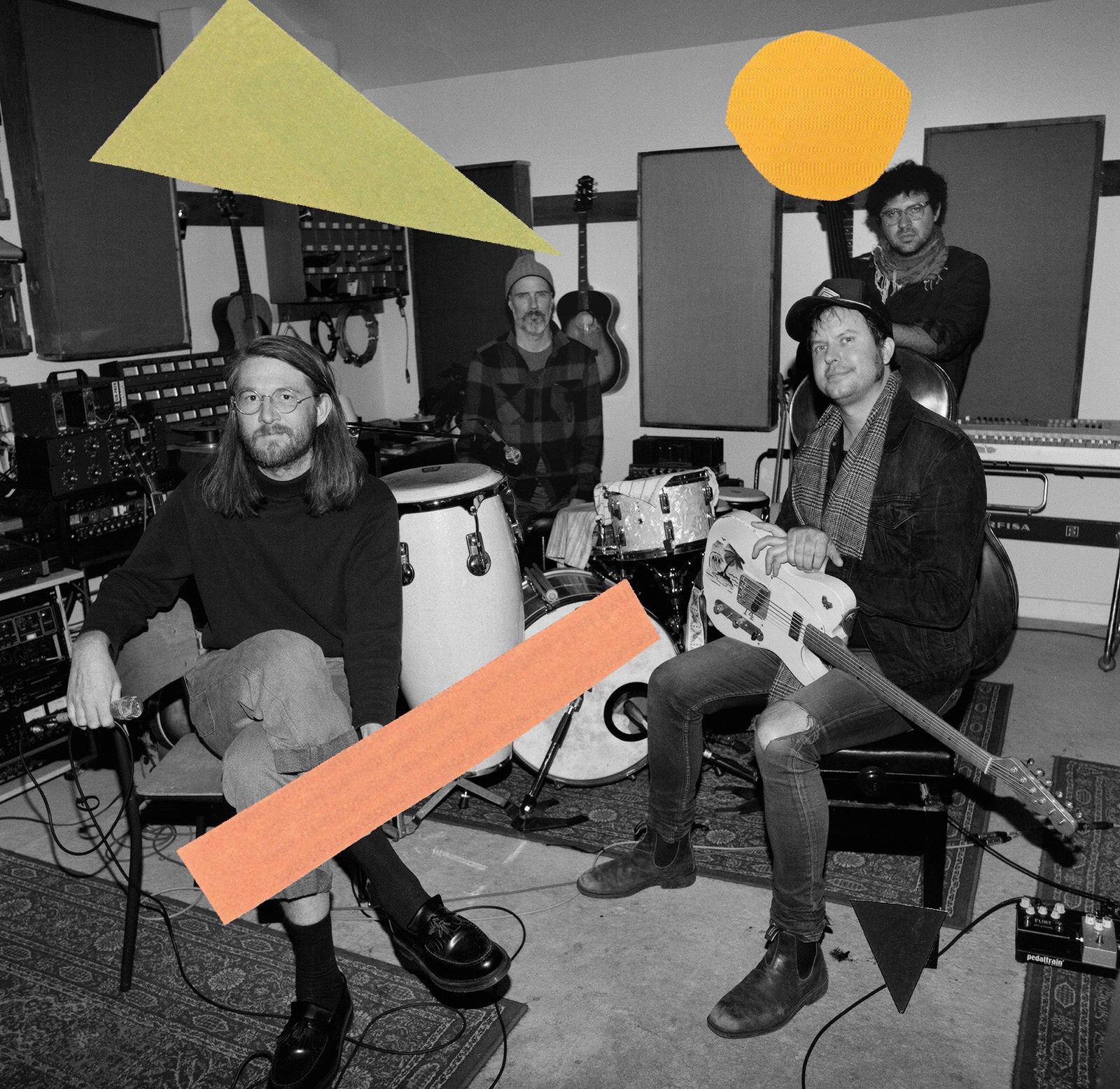
With an eighttrack tape machine, you’re not W orking W ith a computer. You just need to capture what Y ou’re hearing now. g avin makes it very comfortable to be creative and take chances W hile capturing the sound.”
James r obertson

across the country. Robertson terms it “a juggernaut of a band, but also a unicorn in that it gets opportunities no other band has. For instance, we did a corporate event with Gene Simmons (KISS) in Calgary a month ago. We’ve been up to the North Pole, and just played a series of shows at fancy hotels.”
Robertson doesn’t play every single DG concert, but relishes the estimated 45 shows a year with them. “Nick Rose and Tyler Kyte, the band leaders, work really hard to make sure the members of the band are happy. They are also so focused on new material, so it never gets old.”
Another project dear to Robertson’s heart is the all-instrumental trio he has led for 15 years. A long weekly residency at Toronto bar/music venue Reposado initially saw them reprise movie themes, with plenty of improvising, but he decided to set his sights higher. “When the pandemic lifted and they asked me back, I eventually agreed, but on condition I only do my own songs. My goal was to be able to play for three hours straight, no break and only my own material.” He rose to that challenge, and now, at Reposado and a monthly Hamilton residency at The Capitol Bar, a cozy venue Robertson loves, his trio sticks to that all-originals mandate, though now with breaks. They generally play the fourth Sunday each month, depending on Robertson’s travel schedule.
Those Capitol shows routinely attract top Hamilton musicians, all revelling in witnessing a master craftsman at work in an intimate setting. With the sparse accompaniment of bass and drums, Robertson routinely dazzles with tunes
ranging from ambient to jazz to twang to surf, played with subtle finesse.
Thankfully, Robertson has begun recording this material for posterity. “Last year, I released Prelude To Space, recorded during the pandemic with me playing all the instruments. I recorded three more albums in 2023, and I may distil that to one record and release it. Then we’ll go in to record more, and it will sound very different – fretless bass, guitar, percussion and flute.”
Though now less of a priority, Robertson stresses that C&C Surf Factory is ongoing. “We do two or three shows a year when it makes sense, usually around Christmas time, in Hamilton and Toronto.”
In turn, Cripps clearly relishes working with Robertson. “I’ve always been drawn to players who have not only technical skill but also a real voice of their own, which James has in endless amounts,” he tells HCM
Helping Robertson thrive in such diverse settings are invaluable lessons he learned from a five-year stint in Nashville. Given that famed music city’s status as a real guitar town, invitations to play on records there are a major compliment.
“I started getting calls to play on records down there around 2013,” he recalls. “I moved there in January 2015 and in my first few weeks there I got to play on a record with Dave Cobb (the hot producer who has worked with Jason Isbell, Chris Stapleton and more). It was neat to experience him and the circle of musicians he was working with, all so devastatingly good.”
While based there, Robertson toured and collaborated with Lindi Ortega and toured
with folk/roots group Birds of Chicago, headed by Montreal singer/songwriter Allison Russell. She’s now a Grammy-winning sensation as a solo artist, and her ascent has not surprised Robertson. “You could feel that there is no way this talent can be ignored,” he reflects. Other artists he toured with included U.S. country star Jim Lauderdale and Australian Americana artist Ruby Boots.
Robertson can vividly recall the day he left Nashville to move back to Toronto. “It was March 11, 2020, about two days before everything shut down. It was pretty crazy. I felt like Jeff Goldblum in a disaster movie, running out of my apartment, stacking my car full of stuff. I never went back to my Nashville apartment, but I have returned to work on some records. I love it there.”
His time there proved inspirational for Robertson.
“If you’re lucky, you get to experience true greatness. In my experience you don’t get that a lot in Toronto, you need to go to where it is happening. To me, Nashville was about watching the great people that have internalized what excellence is and are sharing that,” he says.
“You get your ass kicked a lot but then other times you get it, you see it. It’s like cooking. If you don’t know what it is meant to taste like, then you’ll never know if it’s any good. In those situations you can see it happening so you know what your destination is.”
Whatever his future destinations may be, look for now-proud Hamiltonian Champagne James Robertson to arrive there in compelling style. n






By JAMIE TENNANT
WHAT: The youth subculture known as “goth” began in the late ’70s and early ’80s in the U.K. The word “goth” is still used by many, but over time dark music, fashion and culture have cross-pollinated and expanded into a variety of subcultures that revolve around a dark aesthetic.
WHO: Anyone, really. Though it’s a mistake to generalize, dark subcultures are by and large highly inclusive and welcoming spaces for young people and elder goths alike. It can also be a safe space for those who resist societal norms of sexuality and sexual expression, openly welcoming LGBTQIA+ and often incorporating drag culture.
WHERE: Goth and dark events have recently become popular and frequent in Hamilton. Check out Fascination (last Thursday of every month at &ThenYou, hosted by Babette laFlail) or Therapy/Asylum nights (at Casbah, hosted by Dark Hamilton, which promotes dark art, music, fashion, movies and events).
WHERE TO FIND MORE: Look for laFlail @honeyboiler and @fascinationdarkdjnights and Dark Hamilton (@darkhamilton or @dark.hamilton on Instagram)
outh subcultures have always unsettled the mainstream and terrified the
straightlaced
(until someone finds a way to monetize it, but that’s another article).
Only one subculture does this without as much as a sneer or a threat of violence. Like all subcultures, they’re merely misunderstood, thanks to the fact that they might be dressed like they’ve come from a Victorian funeral. Or maybe they look like they’ve been dressed by the costume designer of Hellraiser. Or maybe they just borrowed a look from Gottmik (shout-out Drag Race, season 13!). It’s not threateningscary, it’s spooky-scary. And it’s back, if you’ll pardon the pun, in fashion.
Yes, goth is back, though the truth is, it never left. Goth music and fashion that began in the late ’70s has morphed, melted, and reshaped itself over the years. In fact, the term “goth” doesn’t necessarily speak to everyone dressed in black and made-up in white. We’re using the term for simplicity’s sake. Dark subcultures have always been with us, and the term that works for one might not work for another.
Consider how diverse the music has become. Goths used to listen to goth rock. In the 1980s in the U.K., it meant alternative
artists such as Bauhaus, the Cure, Siouxie and the Banshees and The Sisters of Mercy. Since then, we’ve seen the birth of death rock, cold wave, dark wave, ethereal wave, modern industrial, dark EDM and many other genres. Marilyn Mason was called goth. Canadian rap-metal performer Backxwash might fit under the umbrella. It is, as it turns out, a wide umbrella.
“Goth is so subjective,” says local promoter and musician Babette laFlail. “It can mean greatly different things depending on each individual experience. For lack of a singular definition, goth is consistently dark in some manner. We could be talking about music, politics, poetry, fashion, religion, fiction, or even architecture.”
As laFlail points out, you can trace the roots of goth to long before Bauhaus released “Bela Legosi’s Dead.” You can cite everything from Edgar Allen Poe to Screaming Jay Hawkins to The Doors and the Velvet Underground as precursors to the culture. Add a dash of Victorian fashion and some
/continued on next page


Day of the Dead and it adds up to a way of life that revels in everything dark and possibly spooky.
There’s certainly nothing unusual about people who love the darkness. The horror genre exists for a reason. That’s how Murray Swain found the scene. He discovered a love of Dracula as a small child; today, he still identifies with goth as a culture.

“From 1977 to 1981, I would typically come home from school, slip into my cape and fangs, and roam the streets of my neighbourhood,” he says, remembering how he would wait for hours for the chance to pop out of a hole in the ground and shout “boo!” At 14, he discovered goth, a subsect of postpunk then called “Batcave.” The term was borrowed from London’s legendary Batcave nightclub, considered the birthplace of goth.
“For me, it seemed like a natural extension of my childhood,” he says. “I found a large group of youth who also wanted to look like vampires and other undead creatures that appear like they are straight out of a horror film. Needless to say, I found my tribe.”
Like many folks, laFlail was introduced to dark subculture through music. She’s a fan of ’80s goth, death rock, minimal wave, darkwave, post-punk, industrial, power electronics, and EDM. As a musician, she has an array of projects (including Barbaric Slaptonne and Banananananana) but she is also one-half of local darkwave band Concavity alongside partner Graham Bucci who plays keyboard, sings, and engineers the bulk of their songs. “We sing songs of frustration, pain, depression, and saucy breathy stuff too! For fans of Lebanon Hanover or Boy Harsher, things like that.”
laFlail also presents a monthly DJ night called Fascination (see sidebar). At the moment, there are more dark DJs than bands in the area. That suits the crowd fine; going out dancing to the music is important to the scene, and it’s a way to connect with others who share a passion for the fashion and aesthetic.
“I also enjoy cemeteries, gothic movies, and my black cat,” says laFlail. “The fashion follows when it strikes me. In all seriousness, I see it more and more in street fashion and it makes me happy to see it. We shouldn’t be afraid to embrace what we enjoy and express ourselves how we see fit.”
Goth fashion isn’t just spooky, it’s highly
We shouldn’t be afraid to embrace W hat W e enjoy and express ourselves how we see fit.”
local promoter and musician
b abette la f lail
creative. The style draws influences from punk, new wave, New Romantic fashion as well as several historical eras. The style most often includes dark (usually solid black) attire, dark makeup, and black hair. Swain recalls that goth was popular enough in its heyday that Six Different Ways, a clothing store dedicated to goth fashion, opened in downtown Hamilton. Teen dances and DJ nights commonly had at least one goth/ alternative night. Today, these events draw people from all backgrounds and of all ages. For many folks, dark subcultures like goth are not a passing fancy (though the outfits can certainly be fancy).
“The more something changes, the more it stays the same,” Swain says. “I find this to be true with today’s goth culture. Today’s youth still dress in black and love to dance, but more than that, they are maintaining a strong, supportive, community, built on empathy, compassion, and the love of all things dark and spooky.”
“Like anything, it’s what you make it,” says laFlail, who agrees that the scene can be very inclusive and freeing. “Some embrace their sexuality through it, or it can be used as a means to open up and express yourself creatively through fashion, makeup, or creating your own music or art. There’s no wrong answer as long as it’s genuine and not harming others.”
The strong re-emergence of goth as a cultural force is no coincidence, says laFlail.
“These are no doubt dark times. I have heard some say that goth culture popularizing is a reflection that society has taken a wrong turn. I don’t disagree. There is a lot to be angry with these days. So what better time for a preemptive funeral for the end of it?” n


HAMILTON PUBLISHING HOUSE WOLSAK AND WYNN NOW INCLUDES THREE IMPRINTS PRODUCING FICTION, NONFICTION AND POETRY THAT CHALLENGE, ENCHANT AND REFUSE TO CONFORM.
By JESSICA ROSE
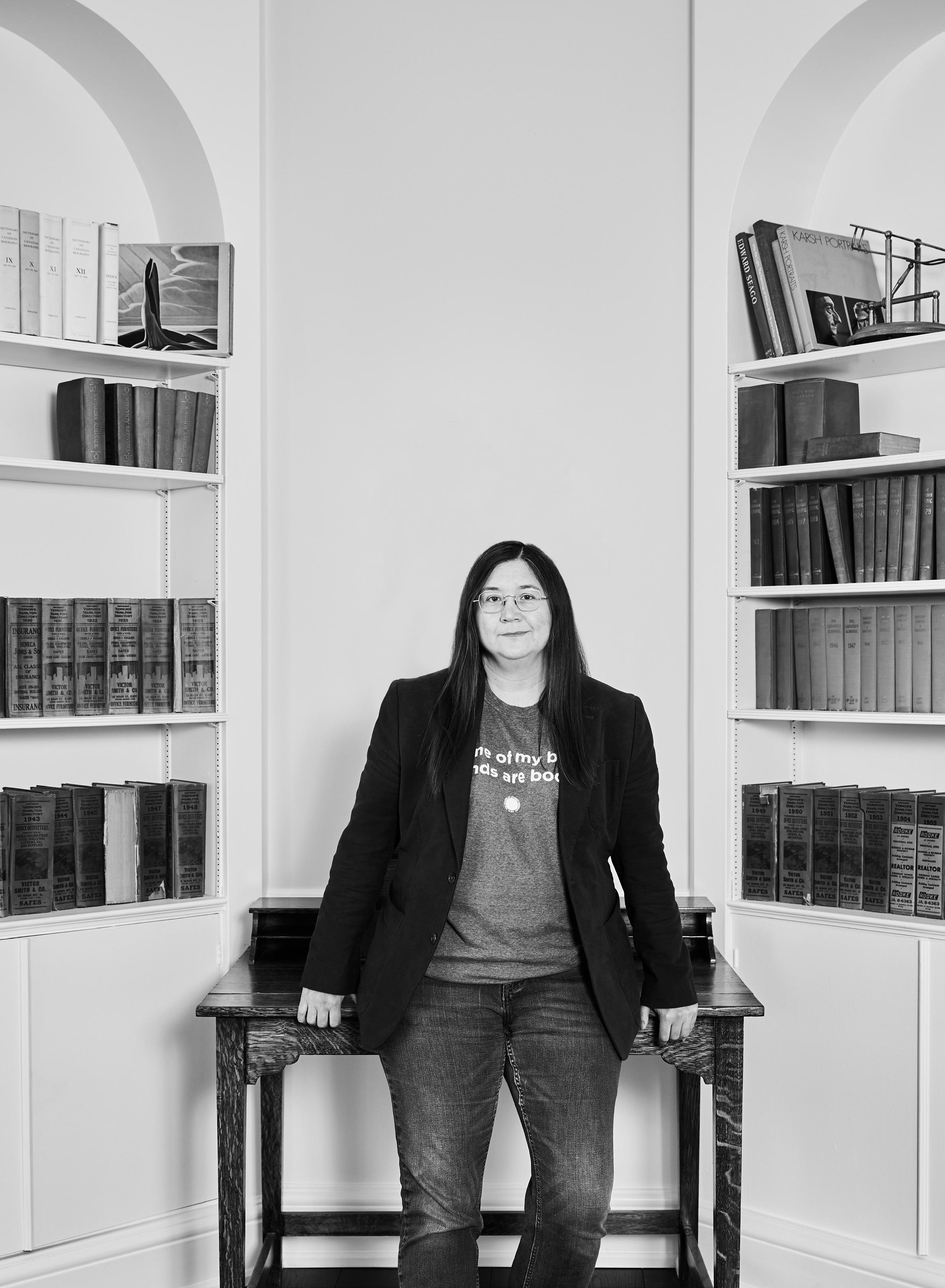
NOELLE ALLEN, PUBLISHER AT WOLSAK AND WYNN, BOUGHT THE LITERARY PRESS NEARLY 20 YEARS AGO AND MOVED IT TO HAMILTON .
Sandwiched between restaurants on James Street North, you’ll find Wolsak and Wynn, a self-professed “charmingly contrary literary press” that’s been publishing challenging, enchanting, unusual, and often awardwinning books for more than 40 years. It was first incorporated in December 1982 by poets Heather Cadsby and Marja Jacobs who were determined to create a space that prioritized the work of Canadian poets.
For its first 24 years, Wolsak and Wynn published only poetry, including The Word for Sand by Heather Spears, which, in the late 1980s earned the press its first Governor General’s Award for Poetry. Now, under the longtime leadership of Noelle Allen, who purchased the company nearly 20 years ago, Wolsak and Wynn releases more than a dozen titles a year, including fiction, nonfiction, translation, and, of course, poetry.
“I moved the whole thing to Hamilton, and that’s when we really started growing,” says Allen, who began her career with the press as its third publishing assistant when it was still located in a small space on Spadina Avenue in Toronto. “Marja hired me even though the only Canadian poet I could name was Dennis Lee,” she says, referencing the author who is best known for children’s classic Alligator Pie
Previously located on John Street, Wolsak and Wynn moved to its current location on James Street North in 2012. A thin space with exposed brick and high ceilings, the former junk shop is nestled between SaltLick Smokehouse and Bar Sazerac. Over a decade ago, when the press moved in, it was Atlantic Fish and Sam’s Hairstyling on either side.
The small Wolsak and Wynn team, which now includes Ashley Hisson (managing editor), Paul Vermeersch (senior editor), and Jennifer Rawlinson (production coordinator), has seen a rotating cast of storefronts and restaurants nearby on James North; however, through all these changes, Wolsak and Wynn’s distinctive blue signage has remained a steadfast presence.
“When I came to the press, it did six poetry collections a year,” says Allen. “We’re so much bigger now.”
Wolsak and Wynn is now home to three publishing imprints. Buckrider Books, led by Vermeersch, publishes “books that refuse to conform,” including cutting-edge literary
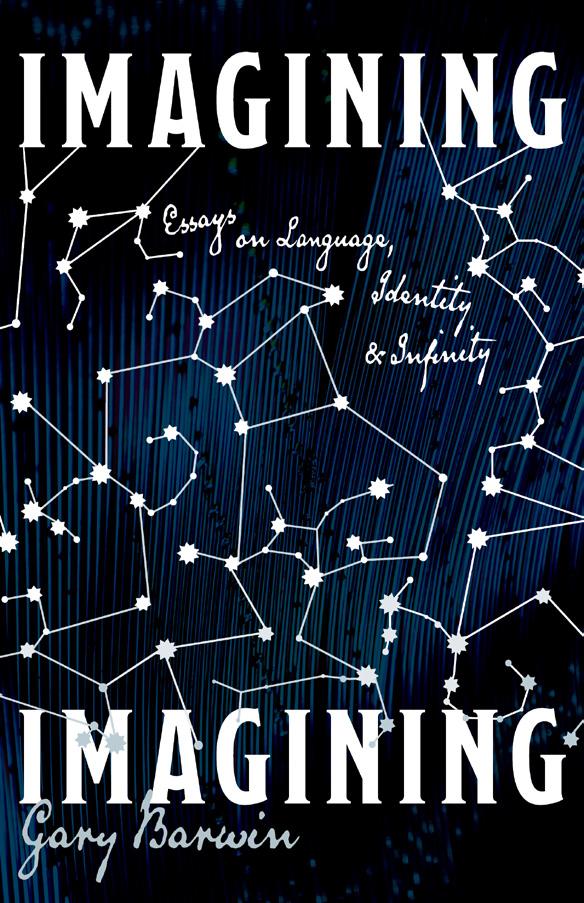
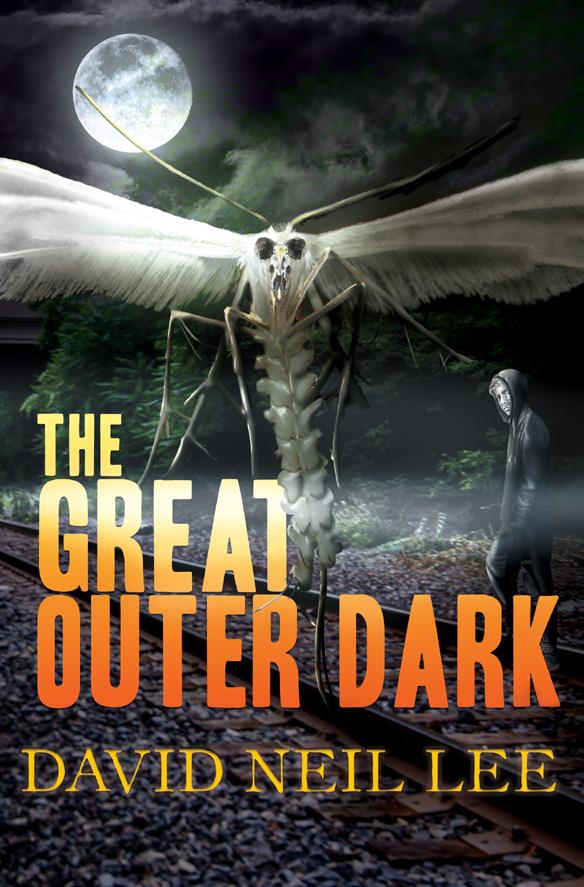

Noelle ofte N has the i N sight to know what might be in a writer, and what might inspire them,
even before they do.”
h amilton author g ary b arwin
works of fiction and poetry. Most recently, the Poplar Press imprint launched for the smart, funny books you read for pure pleasure, including the three books in Peter Darbyshire’s “The Book of the Cross” series that Wolsak and Wynn is re-publishing this year.
Finally, there’s James Street North Books, which focuses on telling the fascinating stories that make Hamilton unique. From award-winning poetry that captures the essence of Hamilton’s neighbourhoods to historical works that investigate Hamilton’s institutions or celebrate the city’s music, these books bring Hamilton to the world.
Titles have included Denise Davy’s book about homelessness in Hamilton, Her Name Was Margaret: Life and Death on the Streets, and the upcoming collection Echo-Mirror by much-loved dub poet Klyde Broox who passed away earlier this year.
Allen says she tries to do at least one Hamilton-focused book every spring and fall.
“People want to read about their city,” she says. “People like seeing their city in a book. They like reading about their history.”
Hamilton author Gary Barwin, whose national bestselling novel Yiddish for Pirates won the Leacock Medal for Humour and the Canadian Jewish Literary Award, has published three books with Wolsak and Wynn.
“Noelle often has the insight to know what might be in a writer, and what might inspire them, even before they do,” says Barwin. /continued on next page
“I like to joke that Noelle tricked me into writing my last book. I submitted a small book of poems. She encouraged me to try writing an essay to accompany it – and, as she knew would happen – I wrote an entire book of essays and ditched the poems. I was so excited and inspired by this form that was new to me,” says Barwin of Imagining Imagining: Essays on Language, Identity and Infinity, released by Wolsak and Wynn in 2023.
“A fantastic editor knows how to draw out the best work from a writer and help them create the best version of the book, maybe even they themselves don’t know that they want to write,” says Barwin. “Noelle did this for me.”
Barwin says Allen is more than a publisher and editor of books. “She is a leader who is involved in many aspects of supporting and developing writing and writers in Hamilton,” adding that she sits on a number of arts committees, arranges literary programming for Supercrawl, and assists with the LitLive



Reading Series. She’s also previously the chair of gritLIT: Hamilton’s Readers and Writers Festival and of the Literary Press Group, a national publishing organization. She’s also volunteered her time and talent to the Hamilton Literary Awards and the Hamilton Review of Books
“This kind of deeply committed and local involvement wouldn’t be possible without being truly grounded in the community,” says Barwin.
Allen is already busy planning the third annual Sharp Words book fair at Bridgeworks, a free event for book lovers to discover new books, talk to authors and artists, and to celebrate writing in our city. She says hand-selling books at book fairs and other events is instrumental to Wolsak and Wynn’s success.
“It’s very, very hard to sell a book,” says Allen. “My joke is that it has never been easier to publish a book, and it’s never been harder to sell one,” she says, mentioning how self-publishing and artificial intelligence have changed the industry, along with the shrinking of arts coverage locally and across the country.
In a blog post celebrating the press’s 40th anniversary, Allen said: “Here at Wolsak and Wynn, we fall for the book first, then we figure out the marketing.” She says finding new ways to connect with people, such as Wolsak and Wynn’s newsletter, is especially important in the absence of a full-time marketing person.
“A lot of people think we’re much bigger than we are,” says Allen. “We’ve been longlisted for the Giller Prize twice. We’ve shortlisted for the Trillium Book Award,” she says, adding that Wolsak and Wynn authors have won multiple Governor General’s Awards and many regional awards.
a local publisher – they’re a Canadian publisher, but they also act as the focal point for the literary scene in Hamilton, and that’s incredibly valuable for Hamilton writers,” she says.
It generally takes two years for Wolsak and Wynn to get a book to press, meaning the titles that you’ll see on bookstore shelves this fall were acquired in 2022. Among them will be Grandfather of the Treaties: Finding our Future Through the Wampum Covenant by McMaster’s Daniel Coleman, whose previous book with Wolsak and Wynn, Yardwork: A Biography of an Urban Place, was shortlisted for the RBC Taylor Prize for Literary Non-fiction.
“I think it’s going to be an exceptionally important book,” says Allen of Grandfather of the Treaties, which introduces readers to the founding Wampum covenants that the earliest European settlers made with the Haudenosaunee nation. “It’s a different way of looking at how we organize our world and interact with each other in difficult situations,” she says.
Allen, who won a 2024 City of Hamilton Arts Champion Award, is proud of the type of books Wolsak and Wynn has become known for, including environmental and political books. Through her work with Supercrawl, she has been instrumental in ensuring that the literary arts are enmeshed in what we think of as art in Hamilton.
“People were very confused because they don’t think of books as art,” she says of Wolsak and Wynn’s early days in Hamilton.
“But books are art! In my mind, they’re one of the most democratic forms of art. For $20, you are whisked away for hours in a novel.”
October 1st - December 20th, 2024
Curated
reception: October 24th, 5-8PM




“I feel so fortunate for my book Smoke (2024) to have been acquired by Wolsak and Wynn because they have a history of publishing excellent books by writers from across Canada, and they really punch above their weight in terms of quality,” says Nicola Winstanley, a local writer for adults and children.
“They are wonderful to work with, too; not only are they nimble, they’re personal, responsive and give their authors room to breathe,” says Winstanley. “I feel that my book matters to them. They are not just
When asked to reflect on what makes Hamilton’s literary scene so special, Allen cites the city’s warm nature. “We tend to come out to support people, which is lovely,” she says. This supportive environment has been key to Wolsak and Wynn’s success over the past four decades.
“We invest in people, and we’re always looking for space for new voices,” says Allen, emphasizing the press’s commitment to nurturing emerging talent alongside established Canadian writers. This unwavering support of authors, in Hamilton and beyond, ensures that important stories are not only heard but also celebrated on a national stage. n

ARE HUMAN BEINGS BORN WITH MEMORIES? A NEW COLLECTION OF ESSAYS BY PEDIATRIC CLINICAL GENETICIST MARGARET NOWACZYK EXPLORES HER FASCINATION WITH THE MYSTERY OF INHERITED AWARENESS – WHAT SHE CALLS MARROW MEMORY.
By JESSICA ROSE
On a dreary afternoon more than two decades ago, Margaret Nowaczyk received the flimsy airmail envelope that would help her trace the lineage of 11 generations of her mother’s family. Inside was her grandmother’s death certificate, scrawled with the name of an unfamiliar place — Horyniec. It’s here, in this small village in southeastern Poland, that Marrow Memory: Essays of Discovery, Nowaczyk’s second book with local publisher Wolsak and Wynn, begins.
In “Marrow Memory” the collection’s eponymous essay, Nowaczyk, who is a pediatric clinical geneticist and a professor at McMaster University and DeGroote School of Medicine, travels to Horyniec with her young sons during a month-long tour of Poland, where she was born.
“The fragrance of the hay drying in heaps as tall as a house wafts by and a sensation arises somewhere between my gut and my heart — I know this meadow, this brook, these storks. But how can I?” writes Nowaczyk, a skeptic and a scientist. “Have I inherited awareness of this place from my ancestors?” she asks herself.
Research has shown that DNA, something Nowaczyk knows a lot about as a geneticist, can be modified as a result of lived experiences. As a scientist, she likes the theory that bathed in happy hormones, her genes have been marked with the spirit of Horyniec. In fact, she’s coined a term — marrow memory — to explain it.
“Muscle memory is something that we develop by repeated actions, like riding a bike. We get on a bike, and the muscles know what to do,” says Nowaczyk over coffee at Mikel Coffee, a favourite spot in Westdale. “This is not what I was thinking about. I was thinking about something very innate, that in some ways we’re born with,” adding that the term draws from existing ideas of epigenetics and generational memory.
“I coined this term because marrow comes from the innermost tissue in the embryo.”
In Marrow Memory: Essays of Discovery, Nowaczyk invites readers to marvel in the unexpected beauty of human experience and the ability of language to capture it. Through sharp, candid essays, she introduces readers to the radio dramas of her childhood in
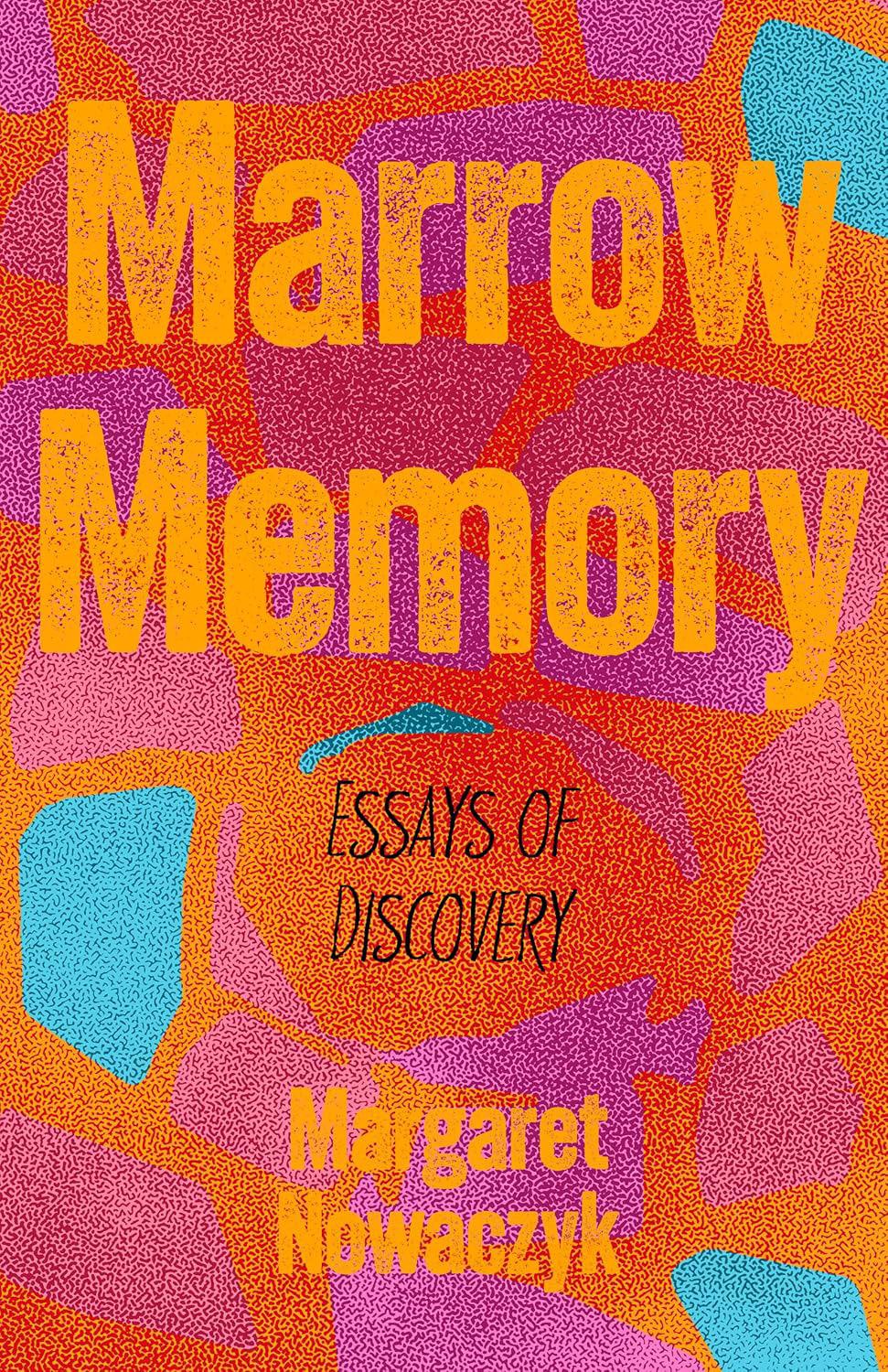
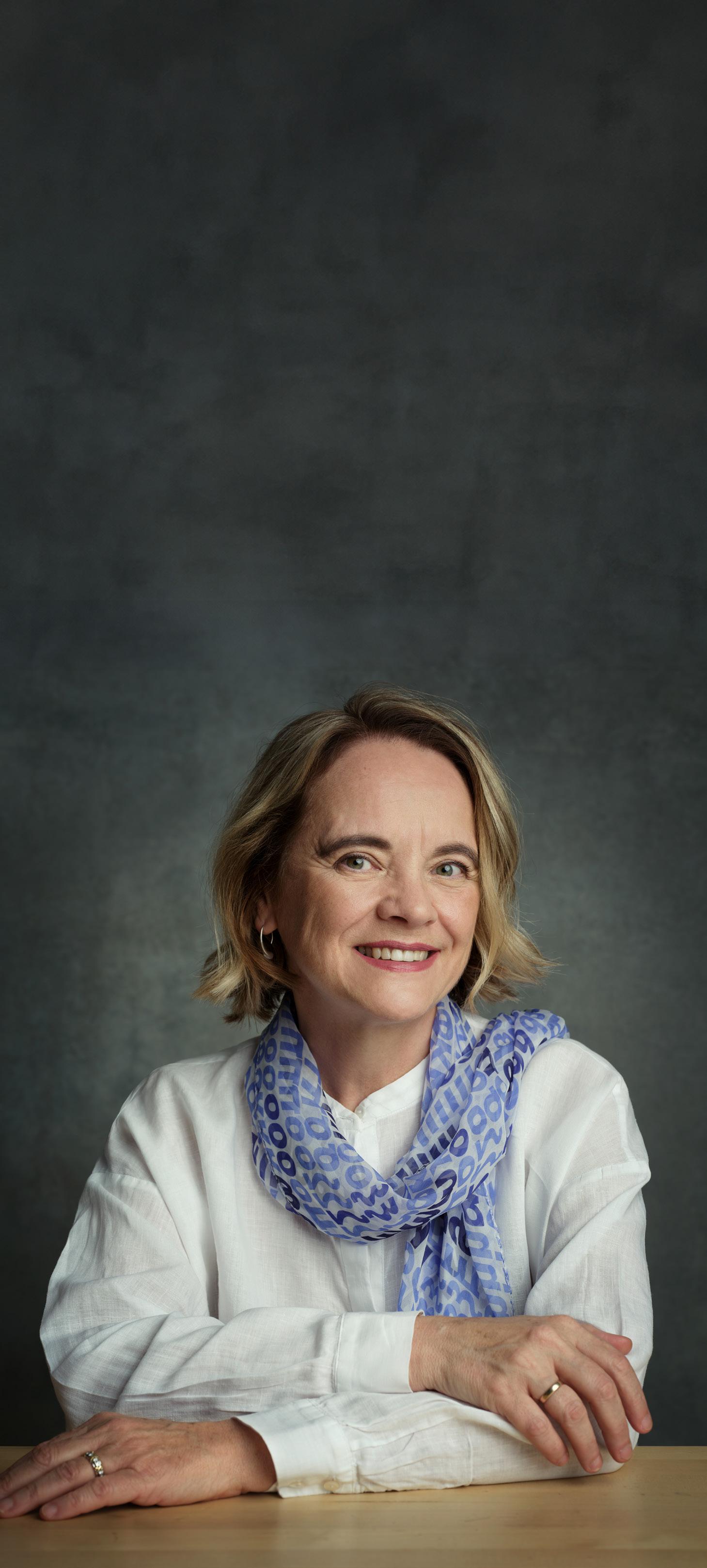
Tigh T ly in T erwoven and in T erconnec T ed like T he cells of T he bone marrow, T he essays in Marrow Me M ory blend T oge T her in T o wha T n owaczyk calls “a cohesive, living whole.”
communist Poland, her fascinating work as a pediatric clinical geneticist, and her tenacious sleuthing as a genealogist.
Nowaczyk’s first book with Wolsak and Wynn, Chasing Zebras: A Memoir of Genetics, Mental Health and Writing, was published in 2021, exploring her journey from Poland to enduring the demands of medical school and living with a long-undiagnosed mental illness. Previously, she published two books in Polish: Searching for Ancestors and Your Family Tree of Health
Nowaczyk was bitten by what she calls the genealogy bug during her maternity leave with her second son.
“Every time you find the name of an ancestor, you pull them from nonexistence,” she says excitedly. “Maybe it’s in the marrow, but finding them resonates with you. I have never met these people and I never will. But something in them is in me, right? Their genes are in me, that’s for sure. It’s almost a somatic and bodily experience finding them,” she says.
One particular ancestor “got her hooks in my imagination,” says Nowaczyk, who pulls her great-great-grandmother Józefa from nonexistence in the book’s essay, “His Aunt Must Have Given Birth to Him!” Here she traces Józefa’s life through three marriages, many children, and her eventual death in 1891.
“I started thinking about her being illiterate, poor, indentured,” says Nowaczyk, who brings other family members to life in the pages of Marrow Memory. Her mother Krysia was born in a church cellar during the bombing raid that began Hitler’s invasion of the Soviet Union in June 1941. Her father was the youngest of six children who never would have attended university in the 1960s without the help of government scholarships, paving the way for Nowaczyk’s career as a doctor and professor.
“In Poland, genealogy has always been the purview of the aristocracy and landed gentry, descendants of knights, princes and feudal landowners, and the historians studying them,” writes Nowaczyk, adding that members of lower classes may remember the names of their grandparents, but those of their great-grandparents remain largely forgotten. “Peasant family trees are stunted; they have many branches, but they break off abruptly after only two or three divisions,” she writes.
Marrow Memory is a composite of things that delight and preoccupy Nowaczyk, the
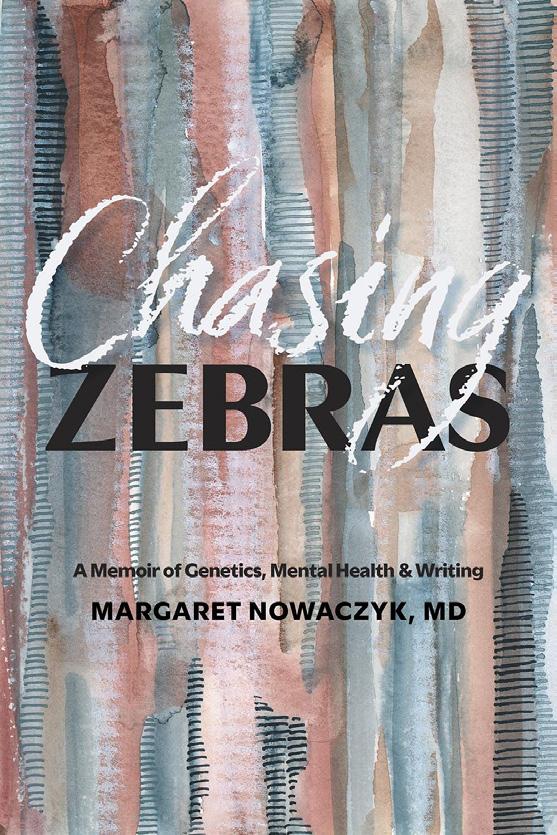
thrill of adding new names to her family tree among them. Other obsessions and influences include her fascination with the mystery of memory, how we react to and interpret it, and its underlying molecular changes, as well as her preoccupation with the naming of natural phenomena in unrelated languages and with the feminist intersection of the personal and the political. The essays “reflect the unadulterated workings of my mind, the marrow of my being,” she writes.
“Margaret is exceptional in her ability to write about scientific topics in a way that draws the reader in, without ever feeling like she’s over simplifying,” says Noelle Allen, the publisher at Wolsak and Wynn who also edited the collection. “You can see her intense curiosity and dry humour throughout the book, but it particularly shines when she’s opening up scientific topics for the reader,” she adds.
Nowaczyk, whose family left Poland in 1980 and arrived in Canada a year later, has lived in Hamilton for 27 years, where she now lives with her husband and two sons.
“I have some really good writing friends here,” she says. “Everybody is wonderful, welcoming and supportive,” she says, adding that she always wanted to be a writer, but did nothing about it for a long time.
“Or rather, I sublimated the writing desire into medical writing, research papers, and medical articles,” she says. “Then, in 2006, I was hospitalized for serious depression, and after that, I decided that maybe it’s time to start taking creative writing courses.”
She went on to do her MFA in creative
writing at the University of British Columbia. When asked if there are any topics that are difficult to write about, Nowaczyk says that writing about her own mental health has never been a challenge.
“I think people find things difficult to write about when shame is involved, and I was never ashamed of my diagnosis … There’s stigma attached to mental health, and I don’t share it. It’s biology; it’s biochemistry. This is just the way my body works,” she says. “I actually felt that it was important to share my story for the sake of education and for the sake of lifting the stigma.”
Marrow Memory employs several essay forms, including a braided essay, which brings together chemistry and personal history, and a hermit crab essay, a form that borrows the structure of another type of document or genre to tell its story.
“There are many different forms of essays, just like there are many different forms of poems,” says Nowaczyk.
She writes at a large table at home where she’s able to spread out her work. “Even though my computer’s there, I always write longform first. I always write with a fountain pen on scrap paper,” she says.
Nowaczyk fits in writing when she can — sometimes in the morning, sometimes at night, and sometimes in between her many other duties in a busy career. She enjoys the process of writing shorter pieces.
“You can really pay attention to the craft of writing, which can be hard to sustain over a 300-page memoir,” she says.
“When it comes to writing, I’m a sprint writer not a long-distance writer,” she says.
Smaller essays are not so overwhelming when it comes to revisions.
“You can work on the word choices, the style, and the syntax. You can really, really polish and chisel an essay.”
Tightly interwoven and interconnected like the cells of the bone marrow, the essays in Marrow Memory blend together into what Nowaczyk calls “a cohesive, living whole.” It’s an exceptional collection that skilfully brings together art and science, illuminating the profound connections between genetics and personal history.
While reading each thoughtfully crafted essay, one can’t help but wonder how their own marrow memory might hold traces of ancestors and their forgotten stories. n

The Colour of Joy, a curated exhibition, Dawn Grant Celebrations, the Women’s Art Association of Hamilton
The Art of the Build, CoWork Gallery
Join us at the 1st Annual Hamilton Art Fair, hosted by the Cotton Factory!
Celebrate Hamilton’s thriving art and design scene. Connect with local artists and designers, explore their creative process, purchase unique works, and enjoy talks, films, life drawing sessions, and more. Discover the art and business of design in a dynamic, community-focused event.
SEPTEMBER 26 - 29th
OPENING | Thurs. Sept 26th, 7 - 11 PM
Cotton Factory, 270 Sherman Avenue North, Hamilton Send inquiries to info@coworkfactory ca
Tableau Vivant: The Art of Conversation Installation Of Light + Colour: Sculpture, Gallery 206
FRI. SEPTEMBER 27TH, 7 - 11 PM
Creative Convergence: The Art of Design Showcase Talks and Presentations
SAT. SEPTEMBER 28TH, EXHIBITIONS OPEN AT 4 PM COCKTAILS, MUSIC, & CULINARY MAGIC!
An unforgettable evening with Chef Ken Lefebour of Nelly James as he previews dishes from his upcoming cookbook, “I’m Just Gonna Fucking Cook,” releasing in 2025. Tickets $25 Eventbrite 7 - 11 PM
SUN. SEPTEMBER 29TH, 12 - 6 PM
Creative Convergence: The Art of Design Showcase
Costumed Life Drawing - Main Event Space -
Blue Water Gold Listening Party (bring
PM
Sponsored by

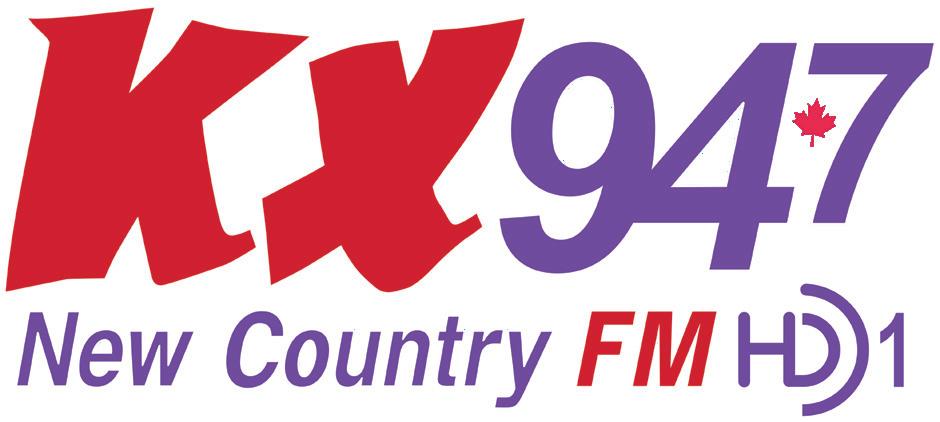

COVER LOCAL ALBUM
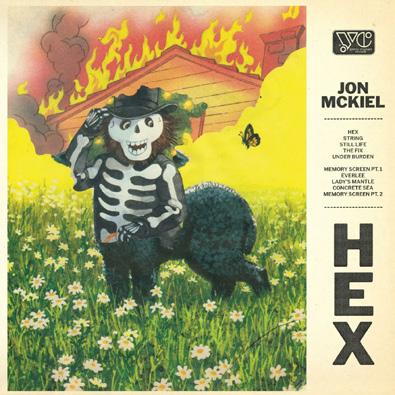
Sometimes an album comes along that you can’t place. You can’t put it in a category or explain it easily to people. It falls into the “indie” realm, but is it folk? Is it rock? Is it weird? Is it from the future?
It’s Jon McKiel’s Hex. Made in the quiet, unassuming, far from hip, cool or trend-setting Sackville, N.B., the album of pseudo-vintage, hypnotic loops, disorienting charm, nostalgia, hipsterdom, and human connection fight each other with marshmallow boxing gloves in front of the taco truck. I can’t recommend it higher and that’s why I’ve included it here even though it’s not local. Stand-out tracks: “Hex”, “String”, “Under Burden”, “Concrete Sea.”
RIYL: Panda Bear, Portishead, Chad VanGaalen, Animal Collective, Tame Impala

Colour Film, (aka Matthew de Zoete) has released a new album, Half An Hour, which was recorded following the onset of the pandemic and de Zoete recovering from a very serious electrical injury.
Half An Hour embraces a quiet, melancholy tone. The album is a gentle exploration of the self and ego and subtle beauty. It’s surrounded by a soothing atmosphere with delicate instrumentation and crystal-clear poignant vocals and it encapsulates the 10-song release. The inward-looking quality sets a reflective mood that persists throughout the album. These songs exemplify Colour Film’s ability to convey deep emotion through minimalist arrangements and gentle production and it certainly creates a fireplace listening experience. It’s a subtle yet powerful listen that resonates deeply, and Kori Pop’s accompanying voice is a nice touch. The production is crisp and polished, yet maintains an organic feel that complements the band’s emotive performance. de Zoete says, “releasing Half An Hour now is kind of a re-birth for me, and the music still feels fresh and alive.” Ending with the Haunting “Ghost Town” with tremolo guitar and pedal steel is a fitting closure to this newest album in his growing and maturing discography.
RIYL: Donovan Woods, Bright Eyes, Blue Rodeo, Justin Rutledge
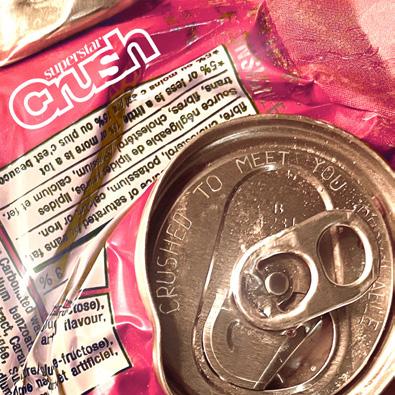
Crushed to Meet You
These young upstarts from Dundas have the gusto, motivation and energy of four toddlers with full bags of half-eaten Halloween candy, and what’s adorable is that they are sharing it and the sugar rush is working!
Crushed to Meet You is a three-song single, a vibrant exploration of pop and rock that bursts with energy and

TEHOHÁHAKE
If there was ever a father and son Canadian dream team, it’d be Tom Wilson and Thompson Wilson.
What we come to expect from these gritty, road-worn songbirds (songcrows) is deep, emotive, cathartic alt-folk and a healthy dose of good ol’ Hamilton R&R. With this release, it is not too much of a musical departure if you know them personally. They show a flip of the script and create 46 minutes and 53 seconds of continuous music (on vinyl, 18 songs if you’re streaming). TEHOHÁHAKE For Exhibit is the first release of a series of ambient meditative music from the father and son collaboration, and it’s an accompanying soundtrack to Tom Wilson’s recent art gallery exhibit.
They’ve made really compelling and mature ambient music, emerging from the city that gave birth to the genre (Brian Eno – look it up yourself). It was all created by Tom and Thompson Wilson, with only a bit of help on pedal steel by fellow Hamiltonian Aaron Goldstein. A Tom Wilson project without his big burly deep voice takes some adjusting to, but you do hear it tastefully placed in the background from time to time.
I didn’t know what I was expecting this album to be, and not much to my surprise, it’s fu&%ing good.
RIYL: Brian Eno (Music for Airports), Daniel Lanois (Belladonna), Neil Young (Dead Man Soundtrack)
charisma, full of catchy hooks and a great rhythm section. Tracks like “Venus in the Drywall” and “Tru Blu” showcase the band’s ability to blend upbeat melodies with clever lyrics. The production is very lo-fi DIY and scrappy, but that is part of the reckless charm of the band and the album itself. One thing is for certain, they aren’t afraid to go for it. The album’s high energy and memorable choruses make it a fun, engaging listen. Overall, Superstar Crush is a lively, enjoyable debut that shines with infectious charm.
The future is bright with these new kids on the block. Get your Crush on!
RIYL: Razorlight, Franz Ferdinand, Talking Heads, Blondie

STEPHANIE VEGH
Ivisited Ravinder Ruprai’s short-term studio nestled in an idyllic Strathcona garden where two massive box frames awaited their transformation. One loomed over us on its easel, while the other lay flat like a patient awaiting surgery.
The solid wood gold-leafed frames are dramatically scaled up from the more intimate Gold Box works she began at the peak of the pandemic, and are almost impossibly heavy with an overwhelming physicality that Ruprai clearly relishes.
“We can only do so many absurd things as artists, right?”
Within these frames, Ruprai is nestling soft sculptures that could imply the comfort of a child’s toy, but seethe instead with the suggestion of swollen bodies, of secret organs exposed to reveal the under-acknowledged pains and ailments that female bodies are often made to bear. A heart made from the exquisitely embroidered blue cloth of her mother’s clothing is scaled to fit a box nested within one of the two large frames – the first piece of a puzzle underway during our conversation, and one that resonates with memories of family members lost to heart conditions.
Her parents, Sikhs from the Punjab region who moved to England along with their first child in the early 1960s, gave birth to six of their seven children in Birmingham including Ravinder before moving to Canada in 1975. Her family established a textile factory in Cambridge that was the backdrop to her childhood and would influence Ruprai’s recurring use of fibre and fabric in her work.
An economic downturn in Cambridge sent the family to Brantford where Ruprai credits her excellent high school art teachers for supporting her application to McMaster’s studio art program, where she immediately fell in love with the small scale of its studio community. She moved to Hamilton at the end of her third year, and has remained here ever since.
Ruprai graduated from McMaster in 1993 and, alongside her musician boyfriend and eventual husband and technical assistant Jamie Oakes, lived “a real rock and roll lifestyle” in Hamilton’s art scene. Her depth of community involvement led to a job at the Art Gallery of Hamilton that combined
exhibitions coordination and public programs before her position was abruptly made redundant during a major restructuring in 1999.
The downsizing was deeply demoralizing. Finding a lack of reassurance among her peers, Ruprai quietly withdrew from the art scene; the difficulties of exhibiting at the Toronto Outdoor Art Fair while pregnant further convinced her that art’s demands were incompatible with her own well-being. Ideas and inspirations remained quietly tucked away while Ruprai gave birth to two more children and focused on her young family instead.
The shockwave of a cancer diagnosis in 2012 as well as the tragic news of her former professor and friend Graham Todd’s death from cancer in 2013 pushed Ruprai back towards art with renewed determination.
“I don’t want to run out of time this time.” While her cancer and family history contribute much to her growing body of work, Ruprai’s explorations of migration and trauma are global in nature; one work in her temporary studio features a meandering red line that mimics the Radcliffe Line of Partition, a dark period lived by Ruprai’s parents yet seldom mentioned in her family. She evokes the trauma of the earth as much as the individual body, tracing genocides and their scars with subtle sensitivity.
She began her Gold Box series of mixed media works in 2021 while undergoing trauma counselling. With three children in remote schooling during the peak of the pandemic, it was a risky and vulnerable time to unpack the aftershocks of her cancer experience – “scary as shit,” as she puts it –with a blunt edge that Graham Todd would have appreciated.
The contents of these box frames contain the traces of what transpired in her body during her stomach cancer, and forge the links between mind, body and spirit that emerge through disease and healing. In her hands, the textiles of her childhood become skin and organs for the body and its betrayals of self, with needlework as a means of suturing wounds. The box itself carries its own symbolic weight – think Pandora – while recalling a scientific habit of compartmentalizing knowledge into parts to be studied like butterflies pinned for display. Braiding is used to tie together the three-

fold forces of past, present and future while speaking to the sacred status of hair in Sikh culture and many others in which women have shared wisdom while braiding each other’s hair. Entangled here, too, is the racism faced by her male relatives who were compelled to remove their turbans and cut their hair to gain employment in Canada, as well as Ravinder’s own hair loss during her cancer treatment.
Everything within Ruprai’s creative language is similarly weighted with meaning. The rug hooking that serves as a backdrop for some of her Gold Box works
is a traditional craft that evokes something of mindless factory labour yet opens a pathway to meditative transcendence in the making. In her lavish use of gold leaf, Ruprai enthusiastically embraces a self-professed Indian love of gold while drawing from western art history in which gold embellished portraits of saints and summoned the Holy Spirit to earth.
Underscoring it all is a search for transformation, and recognition of the self that can surpass its trauma. As Ravinder’s journey has shown, a shining future can always be found after pain and loss. n
Jessica Rose
Liz Worth is a poet, novelist, and nonfiction writer whose exploration of ritual and symbolism doesn’t end with her writing. She’s also a professional tarot reader, a practice that inspired her most recent collection of poetry, Inside Every Dream, a Raging Sea. Her previous work includes Treat Me Like Dirt: An Oral History of Punk in Toronto and Beyond 1977-1981 and her supernatural novel The Mouth is a Coven
“There are parallel processes between writing and reading tarot cards,” says Worth, a two-time nominee for the ReLit Award for Poetry. “Both rely on instinct and intuition, as well as skill and practice. They both rely on duality, merging craft and technique while pulling something out of the ether.”
Inside Every Dream, a Raging Sea explores the thin veil between magic and daily life, making ordinary moments seem extraordinary. The book’s title comes from one of the book’s 40-plus poems, which collectively explore nature, ancestry, and the
MOMMA’S GOING TO MARCH BY JENNIFER
MARUNO

In Momma’s Going to March, retired elementary school teacher Jennifer Maruno shows young readers that advocacy can be fun. The colourful picture book written by the Burlington resident follows several children as they join their mothers at peaceful protests, advocating for freedom, equality, and environmental justice. Together, families make banners, decorate wagons, and beat drums, showcasing the important role children can play in building a better and more equitable world. Maruno’s empowering words are accompanied by vibrant illustrations by Toronto’s Vivian Rosas.
supernatural.
“The phrase ‘inside every dream, a raging sea’ came from a line of questions I was meditating on in regards to my own ancestry,” says Worth. “I started to wonder about the dreams and landscapes of my ancestors: What did they see and know? What visions did they have as they slept? What if it turns out we all dream the same dreams within a family line? Whose memories reside within my bones via inheritance?”
Worth says memory plays a significant role in this book, and much of her work overall.
“When you’re writing, the past is a great place to go digging for stories,” she says. “Much of this collection was written while my mother struggled with dementia, and so that experience also influenced some of the tone and themes throughout. It pushed a lot of the past to the surface.”
Worth, who lives and writes in Hamilton, doesn’t have a fancy writing setup or routine.
AS IS BY BEN ROBINSON

As Is, a collection of poetry by Ben Robinson, is a counter-history of Hamilton, offering an alternative narrative that recognizes the city’s colonial past. Robinson, a librarian in Hamilton, looks at our city’s recorded history through an alternative lens, extracting details that one is unlikely to find in traditional history books. He brings together the past and present, challenging dominant narratives about Hamilton, examining how they define our local identity today. A study of place, As Is is an innovative look at history, connection, and the lasting impact of colonialism.

She simply tries to write something every week, even if it’s just the sketch of an idea.
“Most of my ideas come to me while I walk. Anything can become an idea: A flyer on a telephone pole, a piece of graffiti, an interesting outfit someone is wearing. All you have to do is go outside and inspiration will find you.”
HONEST AS A MOTHER
EDITED BY AMANDA GURMAN

Struggling to manage motherhood? You’re not alone! In the third installment of Honest as a Mother, editor Amanda Gurman curates a collection of personal essays that remind readers that they’re not alone on a wild ride that can be challenging, isolating, and unpredictable. Gurman is one of a handful of contributors from the Hamilton area, including Ann Marie Hemmings, Holly Ngo, Jennifer Foster, and Lorraine Lowry. Honest as a Mother was written by mothers, for mothers, highlighting the not-so-sunny parts of parenting.
From LeBron James to Ben Caplan and from a studio tour of Dundas to nostalgia ’90s-style, this fall offers some exciting arts experiences.

Head to Dundas and paint the town red –no brushes required. The Dundas Studio Tour, now in its 27th year, invites visitors to wander through town, stopping in at five art studios featuring the works of local artists. This year’s theme is community, fitting for an event where like-minded art enthusiasts can stroll at their own pace, while meeting many of the 33 participating multidisciplinary artists. Be sure to pick up a Studio Tour passport. Once fully stamped, it can be entered for a chance to win both a piece of art of your own, as well as the thrill of taking first place in art-perusing. Oct. 5-6. dundasstudiotour.com
Feeling nostalgic for the simpler times of the ’90s, when grunge was new, Forrest Gump settled down for a chat on a bench, and Friends made us believe that we could afford to live in NYC? Fortunately, there’s an event for that at the Staircase Lounge’s TV Powerhang hosted by Dan McRae. Join like-minded ’90s fans at the free monthly event to watch bad ads, cringey shows and reminisce about the pop culture of that decade, all while trying to forget that the ’90s took place over three decades ago. Cringey indeed. Oct. 25, 27 Dundurn St. N. staircasehamilton.ca
Following its 2022 Chicago premiere, King James heads to Theatre Aquarius to kick off its 2024-2025 season. It’s a story of male friendship and the bonding power of fandom. Written by celebrated playwright Rajiv Joseph, the play is anchored by a retelling of LeBron James’ spectacular career, but also recounts the unifying impact that the sport of basketball had on a struggling Cleveland, a theme that will be sure to resonate with sport-rich Hamilton’s audience, even those who aren’t sure what a three-point line is. Sept. 25 to Oct. 12. theatreaquarius.org
Hamilton-born, Nova Scotia-based songwriter Ben Caplan comes home this fall to make a stop at the Bridgeworks at the tail end of his most recent European tour. Not a solo venture, this time the seasoned performer touches down on native soil with a full band to perform a high-energy show featuring his newest songs. Caplan’s soulful style will be on full display as the ensemble performs the moody tunes, proving that his songwriting is as prolific as his signature beard. Oct. 26. thebridgeworks.com
Since being pulled from the brink of extinction, the Westdale Theatre – the1935 Art Deco jewel in Hamilton’s crown – has become a vibrant cultural hub, offering more than just movies. The Grand Dame’s calendar is chock-full of talks, family programming, and luckily for us, some wicked concerts that hit a bit harder due to the restored, intimate setting. Bookmark the theatre’s website and check it often for newly added performances, but in the meantime be sure to add the upcoming shows by Canadian gems Royal Wood (Oct. 24) and Joel Plaskett (Nov. 16) to your personal events listings. 1014 King St. W. thewestdale.ca
/continued from page 27
can seem overwhelming, Hamilton tells participants during week 7. It’s important to get beyond “analysis paralysis,” and he provides a step-by-step guide.
Hamilton then dives into using social media and the importance of an artist presenting themselves online in a way that will appeal to those who might book gigs and those who would come to shows.
“One thing I would stress is that you don’t own anything on social media. TikTok could be banned in Canada next week and it’s just gone. It’s still important to have a domain that you own. I own my domains, luckystickz. com and dejehanhamilton.com and I funnel everything through my website.”
In order to be fully prepared, Hamilton’s booking page asks for details of the event and the space, including duration, setup time, logistics of the stage setup, and even how he should dress. He also asks how the booker heard of him so he can track referrals.
He told the group that they will be asked to perform at venues or events in exchange for “exposure” or a meal. It’s a constant battle. He said he will occasionally perform for free or a lower fee if he thinks potential business opportunities are strong.
“But I choose that. When I am told that the exposure will be good for me, my answer is: ‘Too much exposure is bad for you. It causes skin cancer.’”
To land gigs, Hamilton recommended his students get on the Hamilton Arts Council’s theartycrowd.ca, develop a LinkedIn profile and build an email list. These might not be top of mind tasks for young musicians.
“Emailing may seem old-school but it gives you a connection. Emailing is gold.”
It may also seem old-fashioned, but Hamilton is a big believer in email etiquette: greetings, proper grammar and spelling, and no text lingo. Keep it professional, he says, because you are always seeking your next job.
“Taking care of basic things shows you are ready for an opportunity.”
He also suggests attending events, introducing yourself to organizers and offering to play next time. Stop in at venues and talk to the booking manager.
And every time you get to play, he says, kill it.

“That’s your calling card. I get a lot of gigs because someone has seen me play.”
Other advice: Have an electronic artist package ready to go with a bio, professional photos and contact information; send thank you emails to booking agents, promoters and event organizers; and always put together behind-the-scenes videos of performances to send out on social media.
“If there is an event or venue you really want to play, ask that booker or promoter to your events. It doesn’t matter if they come, you are showing you are in demand.”
And if you do get a booking inquiry, respond as fast as possible. That shows professionalism but also increases your chances of landing that gig.
Jaye Woods discovered The Blueprint after moving to Hamilton from Mississauga in 2022. He has been making music for 14 years under the stage name Orijin, but took a bit of a pause for a few years before arriving in the city.
“So arriving in Hamilton, I came with just an openness to checking out opportunities to be more engaged in creating music and finding creative community.”
He connected with the Shaky Knees Club, a collective of local songwriters that meets monthly for workshops, and regularly puts
on concerts and events for emerging and established songwriters. From there, he zeroed in on The Blueprint.
A therapist by profession, Woods creates hip hop that centres connection, compassion, and community. He started performing at open mics and talent shows and from there, met a producer and manager and played shows around the GTA. He produced five fulllength albums, headlined two Ontario tours, played Canadian Music Week in 2012 and helped to create a small indie label of rappers with positive messaging in their music.
He also earned a nomination for the Covenant Award for Best Rap Album in 2018.
But a career change for his manager and then the pandemic halted that momentum.
“I didn’t have the skills and the know-how from the business side of things, and so things just really tapered down, and so it’s really been the last year that I’ve made a commitment to say I want to reinvigorate my artistry.”
He says he’s embarking with a matured sound and a new message that is linked to his work with adults who are negotiating childhood trauma. The Blueprint has prepared him to handle the business and administrative tasks of being a musician and that will make him a more well-rounded artist, Woods says.
“People show up each week, I sense, with a readiness to really engage, to contribute and to learn, and also that all happens in an environment that feels like a warm community, which I think is a really hard balance to create, but I think Blueprint does it well.”
Other artist development programs offer this kind of teaching and resources, but they cost $10,000, says Woods. He’s grateful for access to professionals like Hamilton and all the other pros he brings in.
“I really cherish having access to something like this. And as somebody who’s new to Hamilton, I see this, and I just tell myself, I would never see this in Toronto.”
Woods says graduates of The Blueprint have formed their own community, a microcosm of his new hometown, which embraces and supports emerging artists in a way he hasn’t seen before.
“People show up to each other’s shows. People show up to events where they don’t even know the artists playing, just to support something local.” n
By Suzanne z and B ergen
Hamilton Prop House burst onto the restaurant scene this summer with an exciting new concept, the likes of which have never been seen before in this city. It’s a working film prop house where you can sit down at one of more than 20 sets and order a coffee, plug in your laptop to get some work done, or meet a client over lunch inside a real train car set. It’s the brainchild of Simon Winterson, owner of Hamilton film studio Digital Canaries. Winterson is big on sustainability, like reusing sets from locally shot films. Welcoming the public to enjoy them is yet another innovative use.
“Where else can you sit and eat on a train set or a patio with a backdrop from a TV show set? Where else can you have lunch and then shop the film wardrobe boutique on site?” Winterson asks as he gestures to the enormous space around us as we sit at the bar.
There are two matching bars, both having once served as the set for the popular Netflix series Drink Masters. The Wellness Bar is alcohol free, while the other, dubbed Bar-Bar, is for those wanting to imbibe.
On the wellness side, you can try hop waters and sparkling
teas from Ontario-made Headwaters Beverage Co. or a madeto-order mocktail from the extensive alcohol-free menu.
At the Bar-Bar, you can try cocktails like The Dude’s White Russian, or Don Draper’s Old Fashioned. You’ll find local favourites from Collective Arts, Simcoe’s Frisky Beaver Wines, and spirits from Brantford’s Manns Distillery.
The Craft Services menu is simple and evolving, currently offering various summer salads plus an assortment of desserts, and locally made Comeback Snacks popcorn.
An adorable train car café bar, connected to the main space but with a quick-access door to Barton, opens in August, where you’ll be able to pick up your morning coffee.
Follow @hamiltonprophouse on Instagram for updates on the opening.
Watch for theme nights, like alcohol-free info night, and speed dating, on the film sets. n
Hamilton Prop House hamiltonprophouse.com
422 Barton St. E., Hamilton

By HEATHER PETER
Impress your hot date with our plethora of elegant and classy eateries within Hamilton and Burlington. From a more casual date for cocktails and oysters, to a refined steak dinner, our city has exactly what you need to impress that special someone. Single, not ready to mingle? These restaurants will make for a great celebration night out with friends and family, too!
VICTORIA’S STEAK & SEAFOOD
470 King St. W., Hamilton IG: @victorias_loves_you victoriasrestaurant.ca
On the corner of Locke and King, you’ll find the luxurious Victoria’s Steak & Seafood restaurant.
The elegant space, alongside a menu of premium steaks and top-notch seafood dishes, will impress any date. If your tastes are on the high-end, Victoria’s is also one of the few places in the city where you can enjoy Japanese A5 wagyu beef. Try dishes like the Niagara honey glazed carrots, the Bay of Fundy sea scallops, or the steak tartare.

RAPSCALLION & CO.
178 James St. N., Hamilton IG: @rapscallionrest rapandco.ca
The dimly lit spot on James Street North just absolutely screams romantic night out. Perfect for the meat lover (though there’s a new favourite dish for everyone on the menu), Rapscallion & Co. offers classy dishes like oysters Rockefeller, lobster and shrimp cappelletti, seared duck breast with apricots, roasted bone marrow, and Denver steak with coffee spice. For a fun weekend date, try the Beatles-themed brunch menu!
345 James St. N., Hamilton
IG: @letambourtavern
letambourtavern.com
At the corner of James Street North and Murray Street, in the old This Ain’t Hollywood space, there’s a beefy new kid on the block. Le Tambour Tavern first impresses with a beautiful space – complete with a kitschy animal musician mural on the wall, a gorgeous circular bar front and centre, and the meat locker with all sorts of beautiful meat cuts hanging in the back. The menu plays host to dishes like escargot, côte de beouf, top sirloin, and elk sliders, to brunch items such as French toast with poached pear, and poached eggs on polenta.
193 King St. E., Hamilton IG: @brogrimmbistro brothersgrimmbistro.ca
In the International Village, located in the heart of downtown Hamilton, you’ll find the Brothers Grimm Bistro. This cozy and romantic underground restaurant feels like a tavern you might find in a fairytale. The cellar-style bistro with a speak-easy vibe serves up European fare, such as smoked cornish game hen, chicharon with arepa, Portuguese shrimp Mozambique, and cassoulet. They have also recently started serving waffles at their Brothers Grimm waffle bar, if that is more your style!
190 Locke St. S., Hamilton 1200 Brant St. B1, Burlington IG: @cimaenoteca cimaonlocke.ca
With a location in both Hamilton and Burlington, CIMA Enoteca is well-known within the community, for both business lunches, meals out with friends and – of course – date nights. Specializing in an Italianfocused menu with Napoli-style wood-fired pizzas and pastas made from scratch, the menu has something for all palates.
10 James St. N., Hamilton IG: @thestandardhamilton thestandardhamilton.com
The Standard is anything but. It is serving up brunch, lunch, dinner and everything in
between, with a menu of specialty dishes you can’t find anywhere else; think crispy fried watermelon, charred shishito peppers, Australian lamb with a sultana chutney, and Belgian flatbread with smoked chicken and brie. For an extra-special date night, try the chef’s table experience with a seven-course blind tasting menu with a full view of the kitchen action. Perfect for the adventurous eater!
970 Upper James St., Hamilton IG: @laspaghett laspaghett.ca
In a tiny little spot on Upper James is a restaurant with big flavour. La Spaghett Pasta House is a rather quaint and cozy space that is perfect for an intimate night out. Pasta dishes are made fresh to order with over 30 pasta sauce choices, all made from scratch. Try the cream vongole, sausage arrabiata, or roquefort rustico – there is an option for every pasta lover!
181 Main St. E., Hamilton IG: @shakespeares_restaurant shakespeares.ca
One of the mainstays of the Hamilton nightout restaurant scene, Shakespeare’s Steak and Seafood has been serving the community for over 50 years. You absolutely can’t go wrong with the variety of fresh seafood dishes or high-end steak cuts. Try the Alaskan king crab legs, grilled scallops, New York peppercorn steak or Hamlet’s Joy (bacon-wrapped filet with grilled shrimp). The Caesar salad here is even an experience, with servers preparing and serving it tableside, as they did in steakhouses of the past.
38 King William St., Hamilton
IG: @conversate.restaurant conversaterestaurant.ca
A newer restaurant on the scene, Conversate Restaurant has opened as part of the King William dining district. With chef Mike Middlemost at the helm, the dishes are executed to perfection each and every time. Dishes like wagyu carpaccio, oysters Rockefeller, tomahawk steaks, beef Wellington, and more decadent dishes grace
the menu pages. They also have a handselected Niagara VQA wine list – perfect for the date who is a wine lover!
KAMOOSH BISTRO
34 Main St. N., Waterdown IG: @kamooshbistro kamooshbistro.com
A farm-to-table experience, Kamoosh Bistro is located in the historic Waterdown Village and is headed up by executive chef Koosh Kahnamoui. The elegant restaurant has an ever-changing menu, based on what is in season, but you can expect to find high-end dishes with an Italian flair. Think: branzino with kalamata olives, sour cherry-stuffed chicken with Venetian pancetta, puttanesca meatball pasta, or cioppino seafood stew. Try the menu of cicchetti (Italian tapas) for a fun date-night sharing option!
37 King William St., Hamilton IG: @thefrenchhamont thefrench.ca
We would be remiss if we did not mention one of the Equal Parts Hospitality restaurants: The Diplomat, Aberdeen Tavern, and (last but not least) The French. The French is a great spot for a sunny lunch date or a business meeting. At night, the warm candle-lit atmosphere makes for a romantic evening; you can almost imagine you’re in the city of love itself! As one would expect, The French menu has exactly that – French favourites. Dishes like bibb lettuce salad with a pickled shallot vinaigrette, steak-frites, trout almondine, and duck breast can be found on the menu.
65 King St. W., Dundas IG: @pinbonesfishmkt pinbones.ca
Pinbones is, first and foremost, a fish market with sustainable and ethically sourced seafood brought in daily. But in addition to servicing Dundas with this fishy amenity, it is also a restaurant that offers creative seafood dishes in an ambiance-filled dining room. The menu is another that is ever-changing as things come out in season, but you can try oysters, ceviche, crab cakes, crab bucatini, whole-roasted fish and more. Don’t be shellfish, share dishes with your date! n

ANCASTER HAS A LOT GOING FOR IT, INCLUDING SOME GREAT PLACES TO EAT AND SHOP FOR FOOD IN ITS MOST
HISTORIC NEIGHBOURHOOD. THIS IS PART OF AN ONGOING SERIES LOOKING AT THE LOCAL ARRAY OF DINING DISTRICTS.
By DIANE GALAMBOS
Founded as a town in 1793, Ancaster has a rich history and became part of the new City of Hamilton in 2002 when the five neighbouring municipalities were amalgamated. Formalities aside, for many it remains “Ancaster.”
By 1823, Ancaster was Upper Canada’s largest industrial and commercial centre and the town boasted the second-largest population in Upper Canada (1,681), behind only Kingston. In addition to its heritage, Ancaster is now known for its natural amenities, beautiful homes and the gorgeous Hamilton Golf and Country Club, which has hosted five Canadian Opens, including this year.
The Ancaster Village Business Improvement Area (BIA) supports the oldest neighbourhood in Ancaster. Its website declares it to be “one of the most unique districts in Canada… (with) modern amenities combined with a remarkable history and historic buildings.” I confess I’ve had little personal history with Ancaster. Heather Peter, the BIA’s executive director, acknowledges that, with the attractions of the local super centres, the Village seems, at times, to be overlooked as a dining destination. Getting more eyes on the Village’s restaurants and businesses is a goal.
My earliest experience with Wilson Street – the Village’s main thoroughfare – was attending an event at the Mount Mary Retreat Centre (which still exists). It included a lunch made by the nuns and I was smitten by their pork chops with apples. I’d never had this before and tried unsuccessfully to replicate the dish. Today, the internet offers more than 7 million such recipes. I’ll try again to make it if I ever finish exploring all the food experiences available in Ancaster Village. Here are just a few.
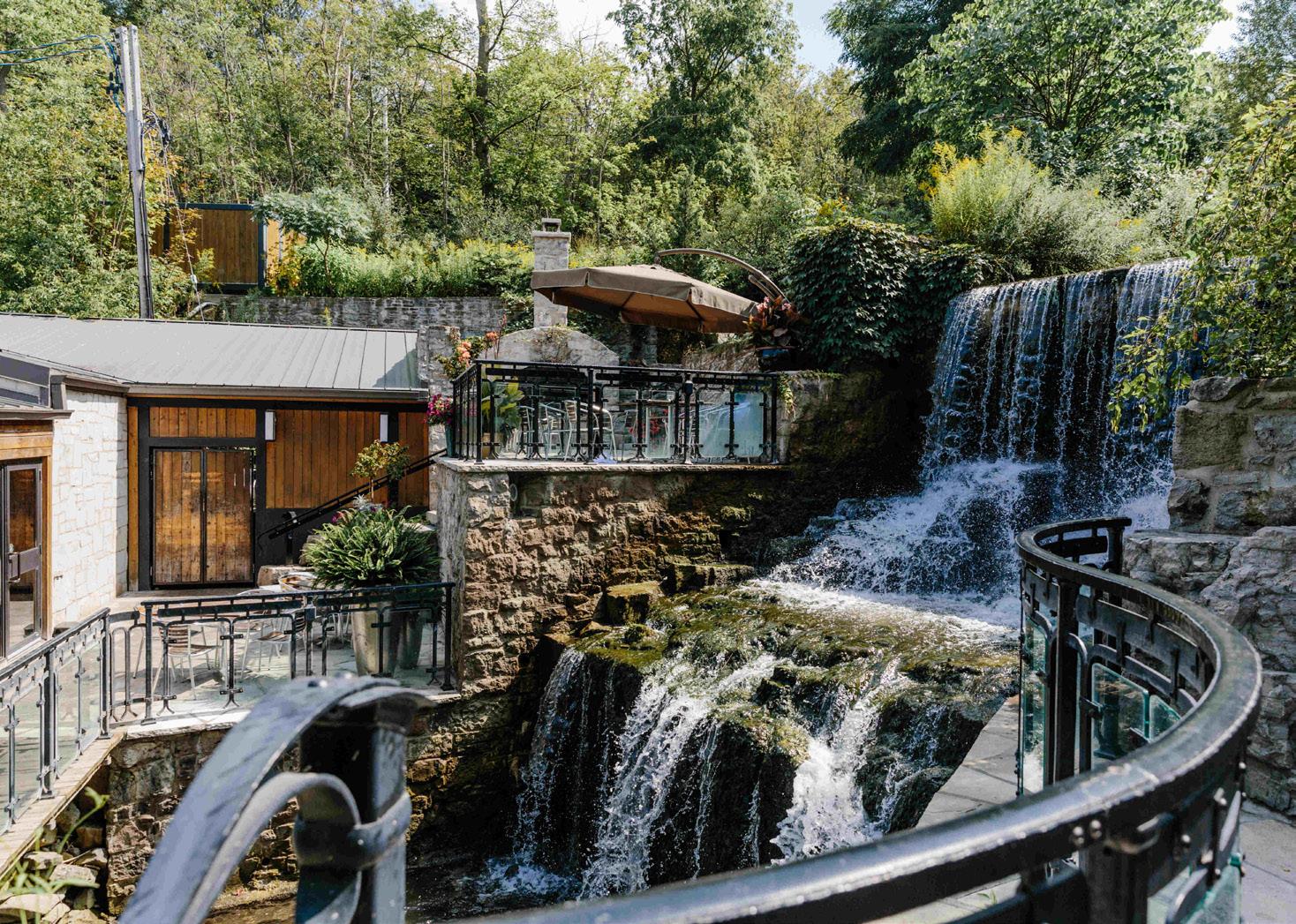
548 Old Dundas Rd., Ancaster ancastermill.ca
IG: ancaster_mill
The Ancaster Mill property boasts two waterfalls, which were central to the operation of a flour mill – the last built in 1863. What remained was brought to life as the Ancaster Mill in 1979 by the Ciancone family, who now oversee Pearle Hospitality.
The natural setting is one of magic and cultured comfort and the backdrop for memorable dining experiences and special events. Ancaster Mill’s weekly programming appeals to a range of diners by offering date-night specials, afternoon teas, Sunday brunch, and iconic Sunday suppers – a threecourse menu of chef-curated dishes served family style.
Their food philosophy is noteworthy, featuring harvest-focused cuisine and seasonal ingredients from their Earth to Table farm and Craft Cut butcher.

1080 Wilson St. W. #1, Ancaster IG: sammysancaster
Sammy’s – an Ancaster icon since 1988 – has a large and strong fan base that has survived two transitions. Ownership passed from the founder to the Kaleci family in 2007 and then Sammy’s moved last year from Cameron Street to the Ancaster Supercentre on Wilson. It offers a more spacious setting, often filled.
Sammy’s owners say they have stuck to doing breakfast and lunch because it is what they do best. I can attest to the quality of breakfast, having visited often for the best home fries. This is a hands-on family enterprise with everyone pitching in with cooking and service. They say: “We love Ancaster and its people … we hope to be around forever. Our Albanian/Greek heritage is translated in the food, homemade quality, and family-friendly/loving care to make Sammy’s a second home for most.”
384 Wilson St. E., Ancaster coachandlantern.ca IG: coachandlantern
Visit this pub for great food and a fascinating history. Built in the 1700s, it is the third-oldest building in Ancaster and even lays claim to ghostly encounters. But nothing is ghostly about the contemporary British pub menu.
/continued on next page
Fish and chips, shepherd’s pie, curry, toad in the hole, Yorkie and handhelds like the beef dip tempt you alongside Thai food and nachos – and so much more. There is much to commend the menu and seasonal changes offer variety. Watch for kids-eat-free specials and take note of the entertainment lineup. The Upper Coach is a welcoming space for special events and the party menu is extensive.
220 Wilson St. E., Ancaster theoliveboard.com
IG: theoliveboardone01
Reserve a table and enjoy a charcuterie board – or do a takeout. Their menu also offers soups, salads, shared plates, flatbreads and handhelds – and desserts. Of course there is wine, beer, cocktails and spirit-free beverages.
375 Wilson St. E., Ancaster brewersblackbird.com
IG: brewersblackbird
Here’s your chance to enjoy beer from brewers who just won a bronze medal for their West Coast Pale Ale at the Canadian Brewing Awards. It’s proudly displayed with a previous silver medal. This team also deserves a medal for resilience in the face of challenges while setting up the microbrewery, which opened in December 2019 and is now a favourite of many.
The décor is charming, with an attractive patio offering shade and sun as well as private rooms for parties and events. The menu (which changes seasonally) has something to please everyone, with a children’s menu as well. One of their most popular items is the wood-oven-fired pizza. Watch for news about a live music program beginning this fall.
370 Wilson St. E., Ancaster cavallonero.ca
IG: cavalloneroancaster
This casual fine dining restaurant that for over a decade has been a village cornerstone transitioned to new ownership in January under Delaney Davis and Chandler

Copperthwaite. For Davis, who grew up in Ancaster, running a family-owned, local business had been a dream and with their extensive hospitality experience, they are thrilled to continue the legacy of the restaurant.
Their menu offers classic Italian food including pizza and seafood all served in pleasant spaces that include an inviting patio. The menu will change seasonally, though some items may become favourite staples. Their gnocchi is made fresh in-house, as well as the sauces and more. They hope to bring back live music in the near future.
370 Wilson St. E. #13, Ancaster indiavillage.ca
IG: indiavillageanc
India Village is, in its management’s own words, proud to be serving amazing customers authentic Indian cuisine for over 17 years. Locally sourced fresh ingredients are transformed into fabulous foods that attract many. I’d been told that they are always busy and this was so even on a weekday lunch visit. The daily lunch special is a sight to behold with almost more food than one person can eat as a midday meal. It comes with one meat selection (and there were many choices), one vegetarian selection (again so many vegetarian choices), rice, salad, naan and a dessert. Note the option of joining a cooking class taught by the executive chef to learn how to cook some of their classic meals.
534 Garner Rd. E., Ancaster southcote53.ca
IG: southcote_53
Southcote 53 describes its menu as striking the perfect balance between comforting classics and elevated favourites with highlights such as calamari, ribs, nachos, wings, sandwiches, fish and chips, ribs, salmon and daily (and seasonal) specials. This is paired with a selection of 16 draught beers on tap from local to international brands, hand-crafted cocktails, and premium wines. They aim to be a go-to spot for entertainment, with trivia and comedy nights, music and even children’s themed brunches. They have spaces large enough for gatherings and celebrations for groups of 20 to over 200. Their attractive patio is dogfriendly – part of the laid-back atmosphere.
21 Panabaker Dr., Ancaster buttiesofscotland.com
IG: buttiesofscotland
Butties has been open for over a year. We visited soon after it opened since it has the closest thing I could find to a full English breakfast. We weren’t disappointed. The Big Scottish Breakfast came with eggs, peameal bacon, sausage, black pudding, haggis, tatty scone, baked beans, tomatoes, mushrooms and toast. These folks – Rachel and Lee Tait – know what they’re doing and, in part,

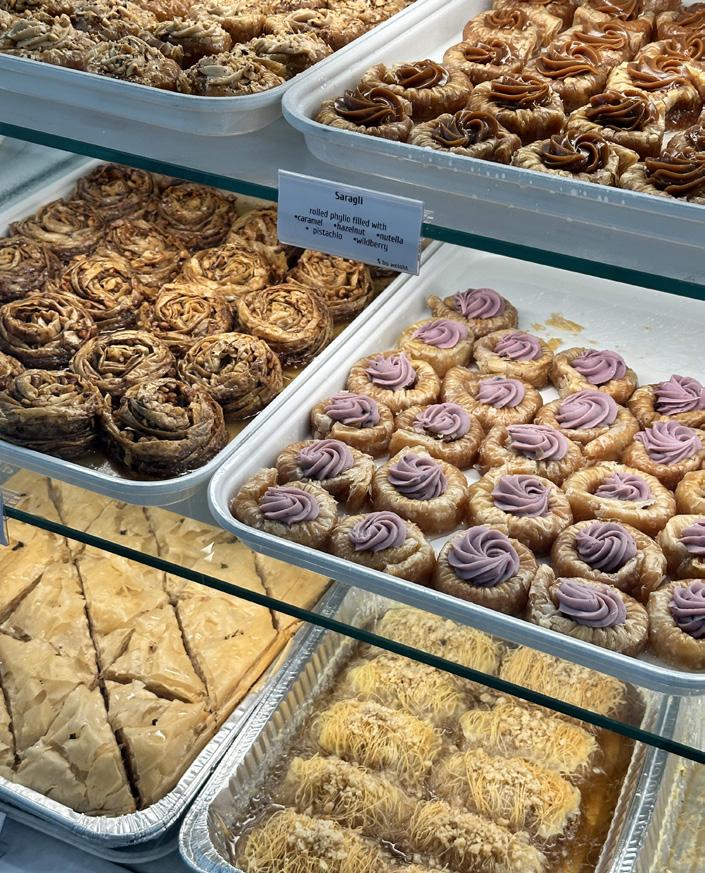
that’s likely because Lee’s parents have long been in the hospitality business back in Dundee, Scotland. In addition to breakfast, the menu includes handheld pies (made fresh every morning), along with burgers, loaded chips and jacket (baked) potatoes. They say they have amazing customers and that a community is taking shape around the eatery. They also sell various Scottish/British products and candies.
356 Wilson St. E., Ancaster ancastercheese.ca
IG: ancastercheese
Trails Cafe @trailscafe_ancaster
Here’s a place with the motto: “Come in as a customer, leave as a friend.” True. One of the most important things you’ll find at Ancaster Cheese is welcoming, attentive service. Oh, and there is also a great collection of fine cheeses. The shop is celebrating its ninth year in operation as a source for all you need for a charcuterie board (try the date night charcuterie box) as well as locally sourced gourmet foods, gift baskets and many curiosities. Owners Arnie Hoffmann and
Milap Bedi are excited about their soon-toopen Trails Café in Ancaster.
1038 Garner Rd. W. #102, Ancaster mistrestaurant.ca
IG: mistancaster
A newcomer to the Ancaster dining scene, Mist describes itself as a restaurant where elegance meets flavour. The family restaurant offers a menu with Middle Eastern favourites and is 100 per cent halal and alcohol-free.
346 Wilson St. E., Ancaster canichebakery.com
IG: canichebakery
Imagine a French-inspired bakery where you can sit and enjoy delicious fresh pastries and coffee/tea. That’s Caniche – where the menu includes croissants, baguettes, breads, cakes, tarts, muffins, butter tarts, pot pies –and so much more. Hand-decorated sugar cookies can be custom ordered. The most amazing treat I purchased was the lemon meringue cheesecake. Divine!
821 Golf Links Rd., Unit 7, Ancaster iosagora.ca
IG: iosagora
Ios is a beautiful Greek island halfway between Naxos and Santorini. It may bring to mind the impressive restaurant ios Estiatorio & Wine Bar on Upper James Street and now the affiliated bakery/market, ios Agora & Bakery. The abundant variety of fresh Greek pastries (not just baklava) is almost overwhelming.
Pitas are baked fresh daily and can be purchased with dips that are served at the restaurant. The freezers are full of take-home ingredients and treats. Imported products include olive oils, a wide selection of cheese, honey, pastas, soft drinks and much more.
scan the qr codes to check out more of d iane’s foodie district reviews james street north king william street downtown dundas hess village
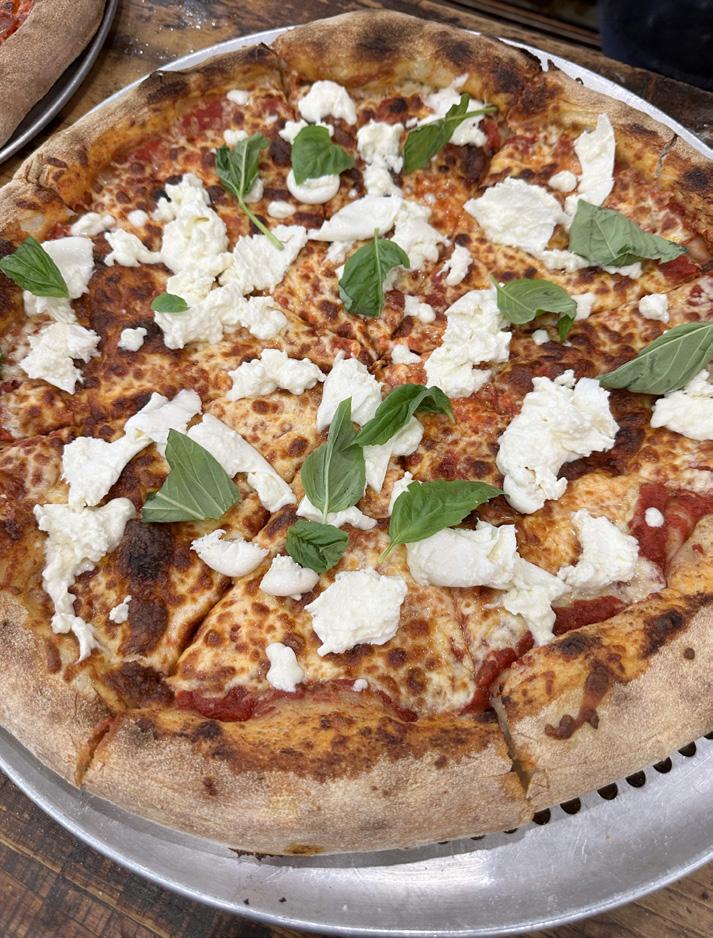
PHOTO: DIANE GALAMBOS
CASTELLI MERCATO
13 Hatton Dr., Ancaster castelli-mercato.square.site
IG: castelli.mercato
IG: capri.gelateria
Castelli, in Abruzzo, was the birthplace of chef Daniel Mancini’s grandparents, first honoured when he opened Castelli Cucina. Anyone who misses that terrific eatery can recapture some of the experience at Castelli Mercato. It’s noteworthy that this is more of a market, but small indoor and outdoor spaces have been created where you can enjoy wine, cocktails, and antipasto – with some of the food coming right from the garden next to you. Long considered to be among the best pizza in town, Mancini’s pizza dominates what’s on offer, along with baked goods such as bomboloni and cannoli. The freezer is full of take-home dinners, sauces, and arancini and the shelves offer pasta, sauce, olive oil and more. A joyful mercato!
Next to Castelli Mercato is an adorable gelateria also run by the Castelli team. Follow them on Instagram for updates about the creative flavours they create for gelato and sorbet. n
ANCASTER BIA shopancastervillage.com IG: ancaster_village


Interviewed by MEREDITH M ac LEOD
Public service runs deep throughout TERRY COOKE’S life. His father was a superintendent of education in the public school board, his grandfather ran the HSR for years and has his name on the downtown bus terminal, and his grandmother was chair of the public school board. Terry Cooke was a city councillor for nine years and chairman and CEO of the Regional Municipality of Hamilton-Wentworth from 1994 to 2000. He ran in six elections by the time he was 40. And now Cooke is married to Ward 1 city councillor Maureen Wilson. After a 41-year working life, Cooke is officially retiring from his job as CEO of the Hamilton Community Foundation, a post he held for 15 years. Hamilton runs deep in his veins. He lives in the same west Hamilton neighbourhood he grew up in and he’s a proud McMaster graduate.
What prompted your decision to retire?
Well, I’m 65 in August. And we had been doing succession planning with my senior team for about five years. So this was part of a longterm transition plan, but it got crystallized when I had a sextuple bypass a year and a half ago, which I think makes you think about your own longevity and what you want to do with the time you have left. And I’ve been working since I was 18. So, you know, after 42 or 43 years of getting up every day to do things, and you know, for the last 30 years, it has mostly been in leadership, where you’re constantly expected to perform. I just look forward to more freedom to travel and do the things that I love.
Can you describe the Hamilton Community Foundation for people who might not know?
We are a trust fund established first in 1954 with a single gift of $200 from a widow in North End Hamilton that is now approaching $300 million in assets. We have a broad mandate so we can support any charitable activity across the spectrum from the environment to healthcare and education, but we’ve mostly focused on poverty, and particularly on education. How do you improve educational outcomes for low-income, racialized, and Indigenous kids? And we’re about 10 years into that work with strong partnerships with the school boards and the post-secondary institutions, and so that’s the granting community leadership side of the business. The financial side is we’re also a very large investor, and arguably, I think, the largest investor in affordable and supportive housing other than government. So we’ve done projects all over the country, but we, you know, wherever possible, focus on what we can do locally. So, you know, we’ve held mortgages and helped to buy land and buildings and build new affordable housing with folks like Indwell, Hamilton East Kiwanis, Sacagawea and others. So all of that makes for a really interesting portfolio of things that we get to do.
How has the HCF reinvented itself? Historically, the model of foundations is we grant 3.5 per cent or 4 per cent of our income on our assets. And what we set out to do shortly after I started, was to become a leader in impact investing in the country, which we’ve become. So instead of 4 per cent of our assets being deployed to support our mission, we’re now about five or six times that. So somewhere between 20 and 25 per cent of our assets are directly invested in things like affordable housing and renewable energy. So we’ve multiplied the impact dramatically and leveraged that to get other capital into these areas of high need. And obviously, when you’re talking about affordable housing, it’s a huge crisis and priority across the country, but especially here, right? So the business looks nothing like it did 15 years ago when I started, which again, makes it really interesting. We have had unbelievably courageous boards who have said to us, we don’t want to dabble in these things. We want to be a national and international leader. And frankly, this community foundation has always punched way above its weight, and has been recognized nationally and internationally for innovation. And I know that’s going to continue.
What are you most proud of in the work of the HCF?
Simply our relevance to important issues in leadership in Hamilton. I think of the Hamilton Anchor Institution Leadership that were previously all working on their individual responsibilities, but doing less together. I think increasingly on issues like addiction, mental health, homelessness, it’s going to take the combined focus of all of the major institutions to make a difference. So, I think there are a whole bunch of things I’m proud of, but the reinvention of our business to leverage more impact on important issues in Hamilton would be probably at the top of the list.
Tell us about your successor as CEO, Rudi Wallace.
So we hired Rudi three and a half years ago from the Victoria Community Foundation. He moved his family here, bought a house and has one child, and another one on the way. He’s led our grants and community initiatives team in a very dynamic way, especially with equitydeserving communities ... He’s the right choice to lead this foundation into our eighth decade
in existence. I just finished spending a couple of hours with him and I know our fundamental values – respect, kindness, innovation, collaboration – they will continue. There’s new energy in the organization, but there’s also continuity and a respect for how we got where we are.
What’s next for you?
It’s funny, one of the questions I’ve had since my retirement event was, am I going to run mayor? And I said, “Are you out of your freaking mind?” Really? I retired from politics 25 years ago at age 40. So, that ain’t happening. I’m going to travel, sit on a few boards, cheer for my kids and work on my golf game.
What’s the most Hamilton thing about you?
Oh, having spent a summer working as a helper on the beer truck on Barton Street. So, I was in every club and strip joint joint on Barton Street when I was 18 and 19 years of age, which was a perfect precursor to life in politics, because you learn how to deal with people from all walks of life.
How do you describe Hamilton to people from other parts of Canada or around the world?
It’s the fastest changing, mid-sized city in the country. It is a place utterly devoid of pretense. It demands our very best, but it can also break your heart. And so I’m the eternal optimist, always positive about the potential of this place, and I’m also mindful that too often we’ve been let down by a political culture that doesn’t see the big picture and is afraid to change.
What are the pros and cons of retirement for Terry Cooke?
The pros are time, because time has always been at a premium for me throughout my adult life, and I think of all the books that I haven’t read that are in my library. I think of all the places that I would love to travel, that I haven’t yet gotten to, because I love exploring new places, and I just love time to spend with my kids. On the con side, purpose has always been critical to everything I’ve done. The need to find a relevance between what I do every day and the well being of the community, and I’m going to have to find new ways to find purpose in the next stage of my life, because I’m not going to have a job. I don’t want to default to doing things to fill time. I want to do interesting things with interesting people. n
TONIGHT, TOMORROW, THIS WEEKEND, NEXT MONTH? LET US HELP WITH THAT.
HAMILTON CITY MAGAZINE HAS CURATED EVENTS AND ACTIVITIES FROM DOZENS OF ORGANIZATIONS, PROMOTERS, CLUBS AND CULTURAL INSTITUTIONS IN THE HAMILTON AND BURLINGTON AREA.















Instead of endlessly searching the internet, you only have to go to one place: hamiltoncitymagazine.ca. Check out the Things To Do section on our homepage menu and use the dropdown menu Find An Activity to search by the type of activity or event you’re craving. It’s all there for you – including our feature stories that highlight local events, found under Happening Now.

